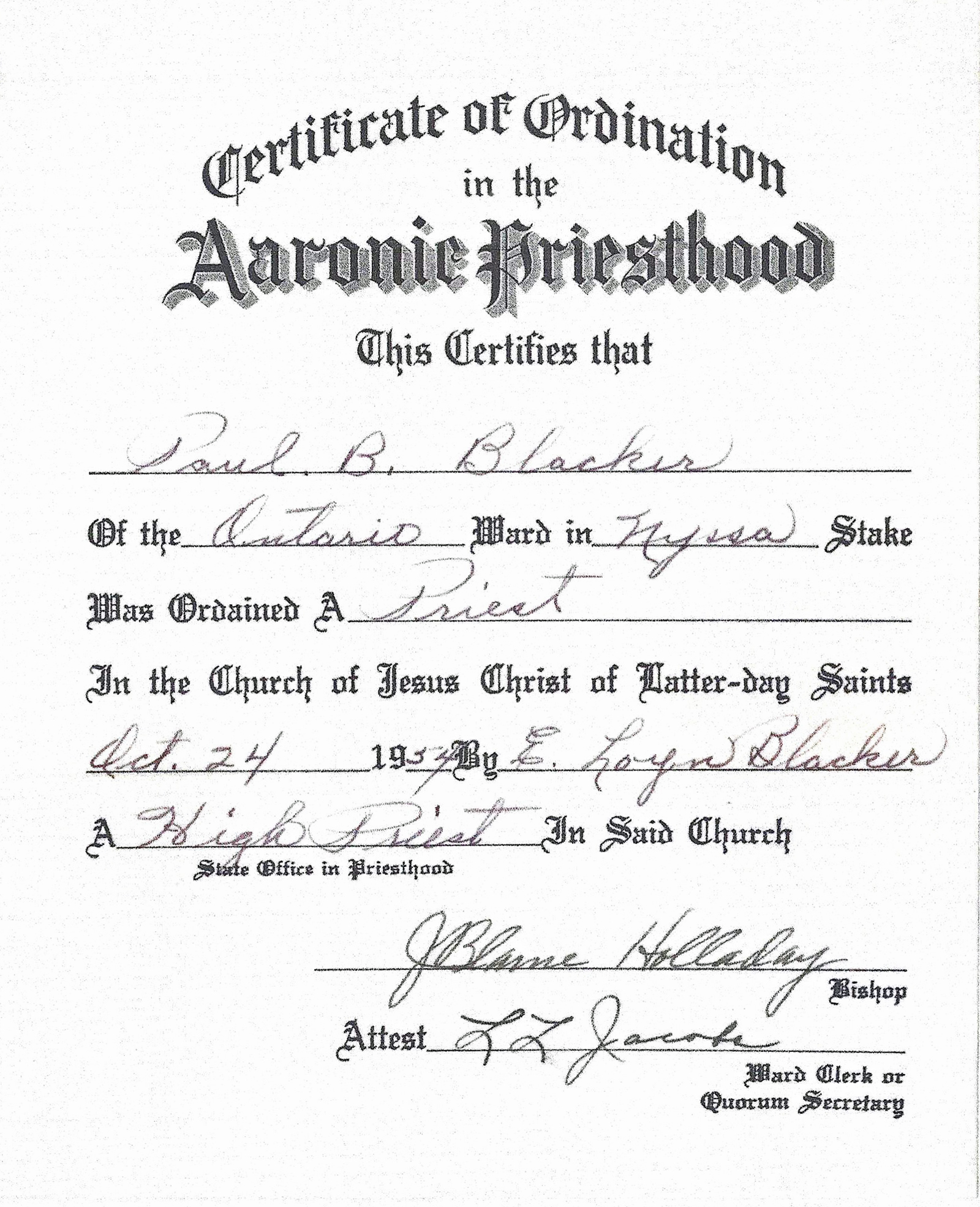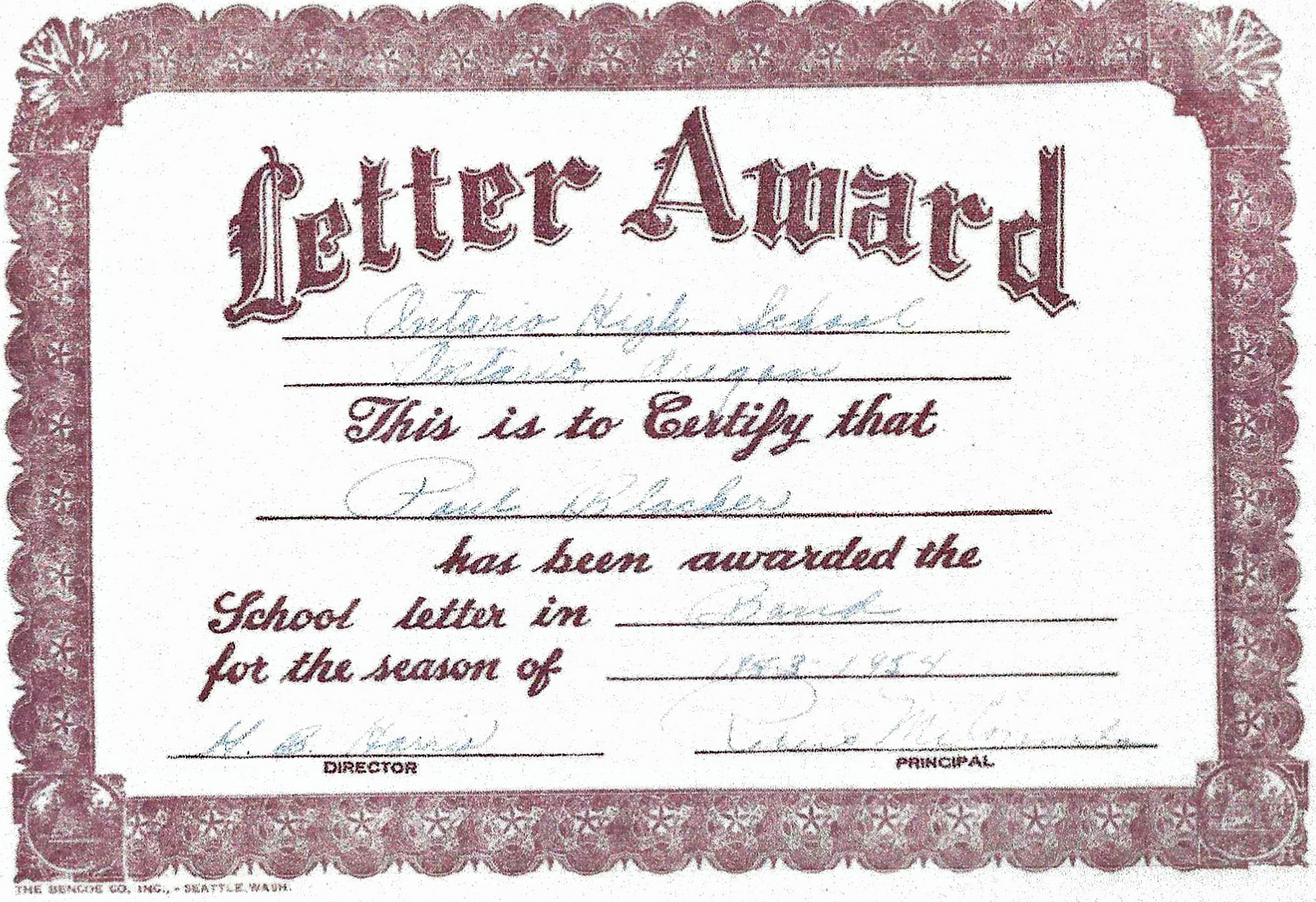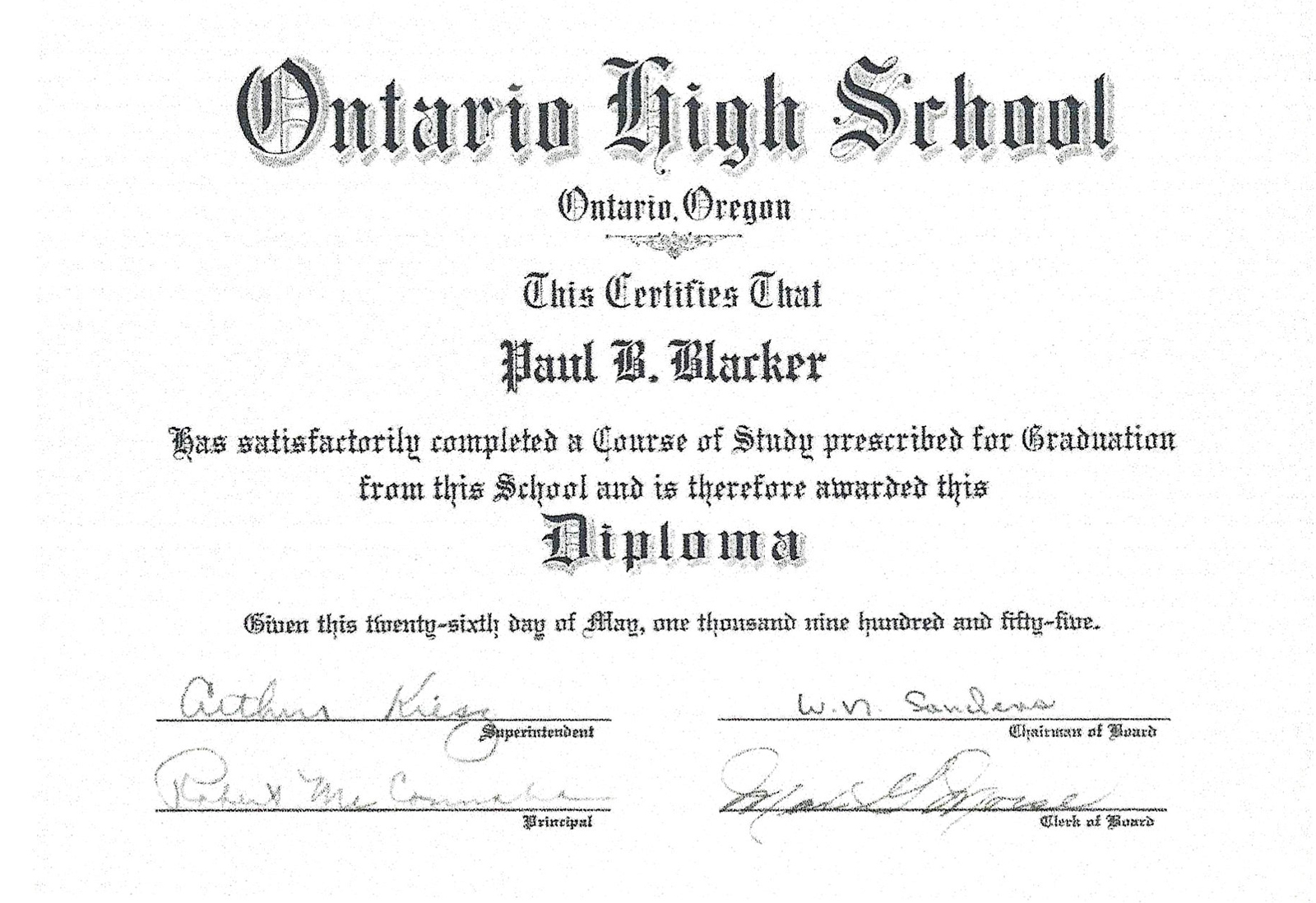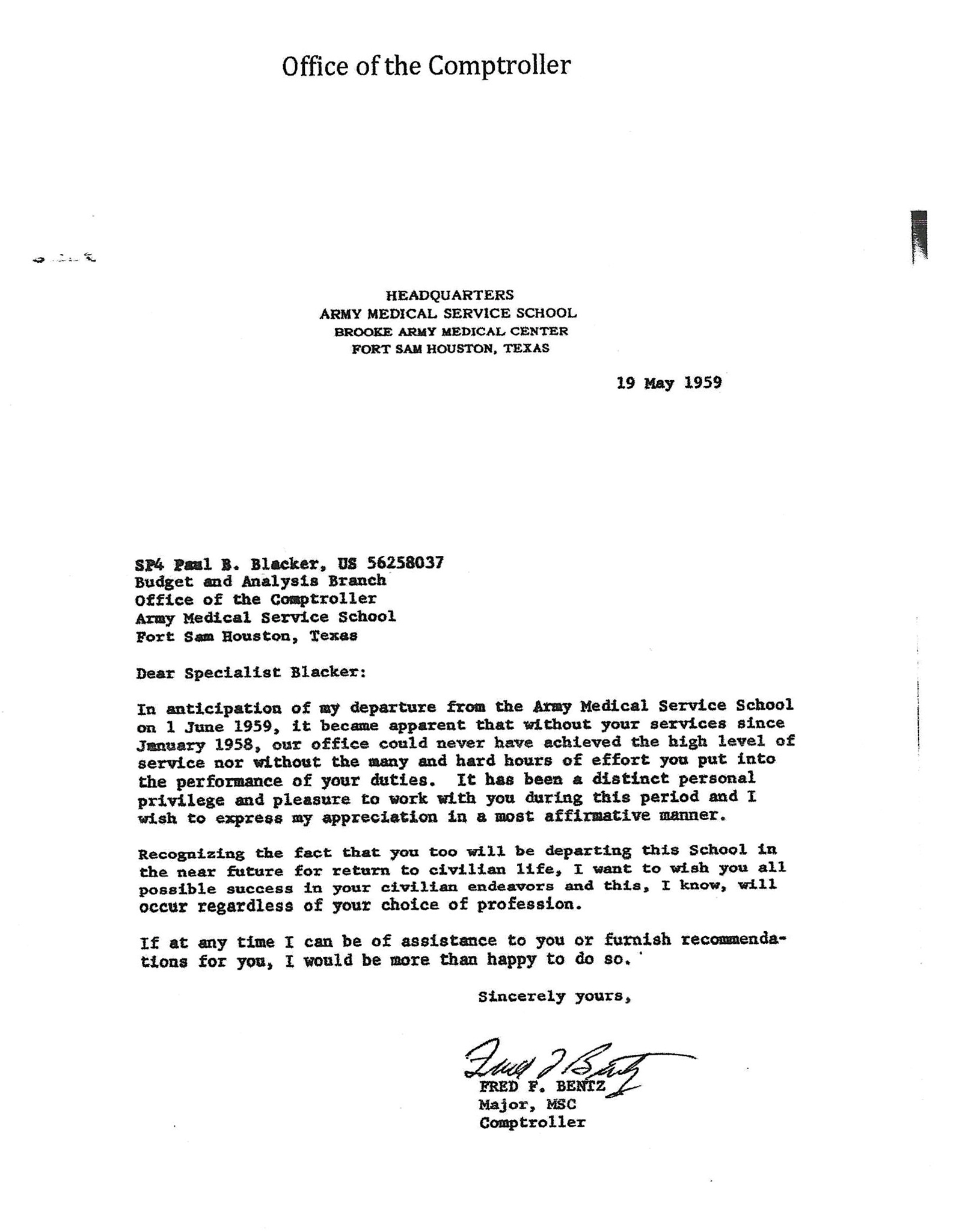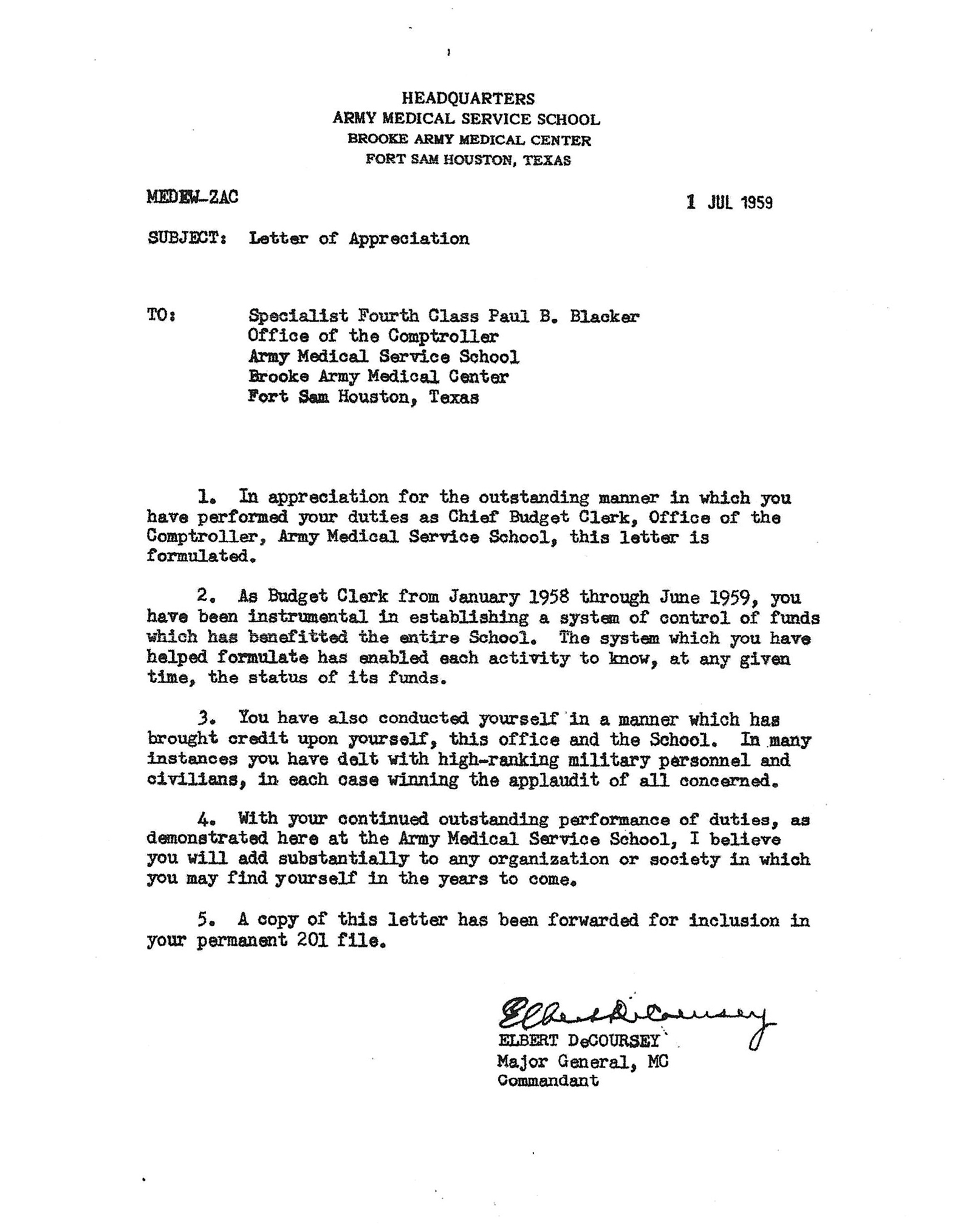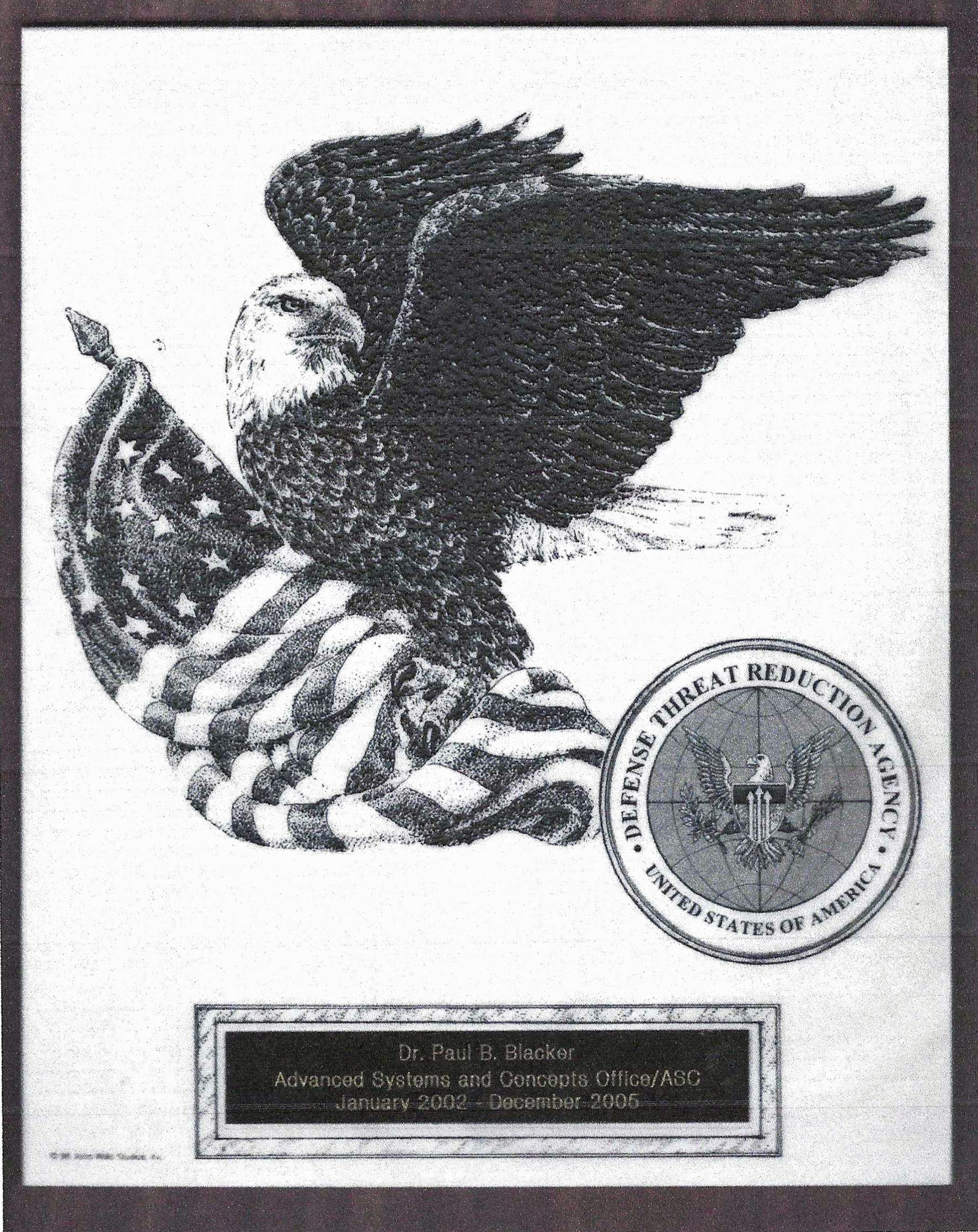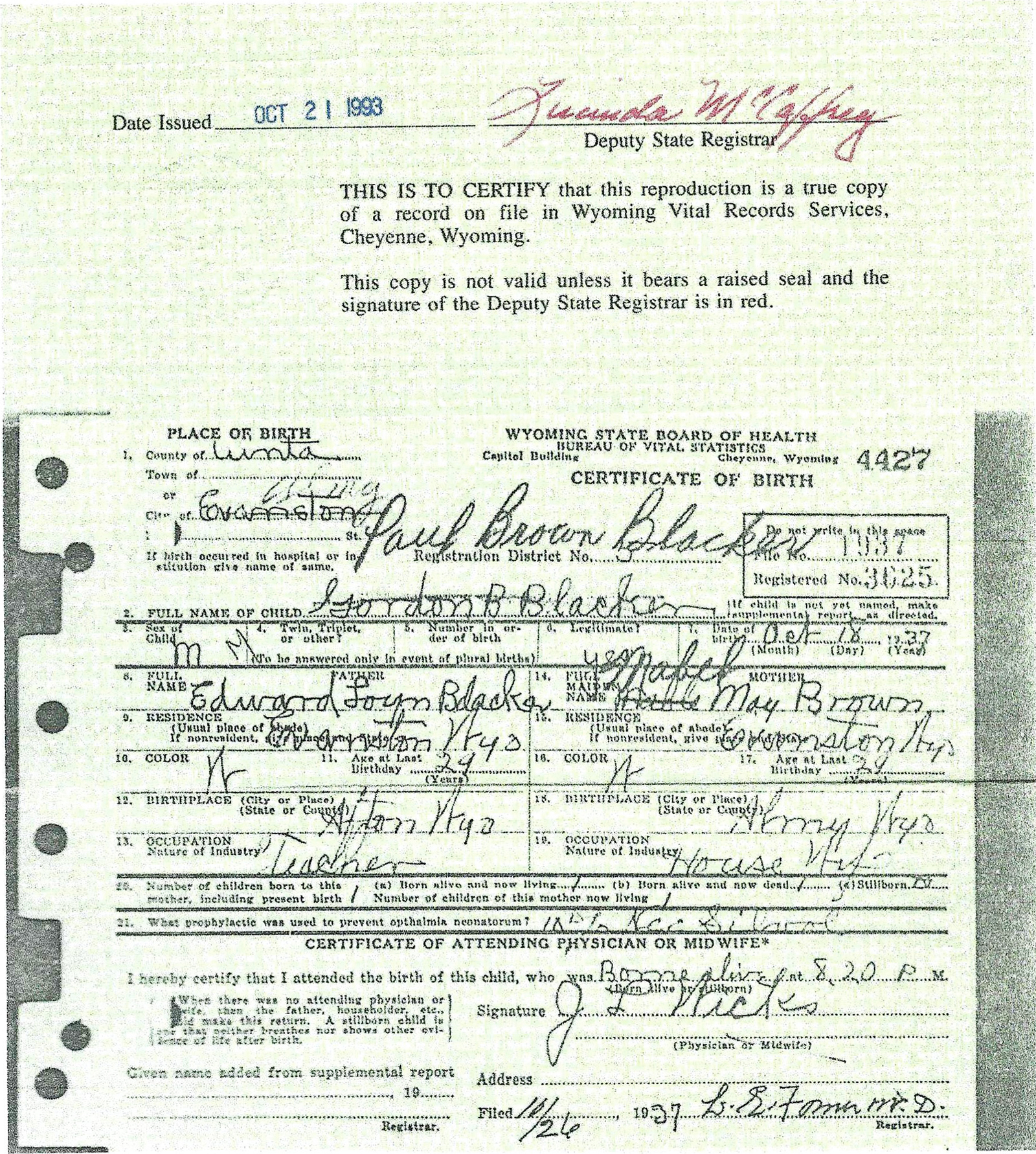PERSONAL HISTORY
Paul Brown Blacker
As of April 2024
1937-
April 2024
I was born in the first half of the Twentieth Century. I have witnessed one of the great periods of human history. It has been a complex time the greatest and most magnificent achievements of man. It has also been a time of the almost unimaginable horrible and terrible events in history. Currents of good and evil swept over the world and threw governments into turmoil and shook the world and redirected the foundations of history. It was a time of great men, in great times, doing great deeds. Giant ideas allowed giant men to do things that astonished the world and changed the affairs of men for good and for evil.
My own ancestors crossed oceans, traveled across the US and settled lands that had never before been farmed or ranched. They lived with the dangers of coal mining, watched their precious snowbound herds die of cold and starvation, buried some of their children, struggled to put food on their tables and shelter over their loved ones and then went to church on Sunday and praised God for their many blessings. Their personal struggles were to better themselves and their children. They asked for little other than the chance to make a better future for both. They were great men and women in country of millions of great men and women. And in their combined and individual struggles gave rise to great things in a great nation.
I saw a heroic, unique and wonderful time of excitement. It will eventually be remembered with jealousy in the ages to come. People will ask themselves "How would it have been to live in a time when the very foundations of Zion were being carved out from the time that the gospel had been taken from man for nearly two thousand years. How would it have been to see the coming together of the twelve tribes and the destruction of all of the nations of the earth? Prophets have only dreamed of these times and yet we were here to not only see it but to actually participate in the great restoration of the 21st century.
The terrible depression had begun eight years before my birth and America was just emerging from the second dip of that tragedy. Along with the depression was the greatest environmental disaster ever to hit the US - the great drought and the resulting dust bowl, had both staggered the nation. These events were fresh in the memories of Americans. The Great War had paused only twenty years before and the basics of the Second World War were already under way as Japan was attacking China and Germany had entered the Spanish Civil War. And yet within a short time, American had achieved the status of the richest and most powerful nation that had ever been. These were great times.
The creation of skyscrapers, cross national transportation, electricity and instant communication, Ships crossed our oceans in four or five days, trains crossed the nation in three, and aircraft went from one coast to the other coast within the same day.
But even more-so, as a teenager I watched fantasy movies of traveling to the moon and to the other planets. Buck Rogers episodes were simply entertainment for youth, adults were too sophisticated to put any stock in such fantasies. I was an adult when President Kennedy announced that "We will put a man on the moon in this decade," a statement that seemed to many to be a line from one of those fantasy movies that was so fanciful most Americans thought it was simply a political stunt. Most astute people knew of the challenges of needing to build rockets of inconceivable power. They knew the need to generate and execute unthinkably difficult mathematical calculations for different trajectories involving not one but three rapidly moving bodies over several hundred thousand miles distance. The development of new materials capable of standing inconceivable extremes of hot and cold and still functioning properly in the total vacuum of outer space.
During that time some diseases have been cured. For example the scourge of small pox, measles, and also polio that literally shut down our communities when there were epidemic outbreaks in my childhood have now been totally cured. The faces of children scarred with pox marks and the withered hands and arms of polio are now never seen. Our children have no idea of the dread they have been spared through the brilliance of the scientific findings of our medical researchers.
I now continue my life into the first half of the twenty first century. Now, people with fatal conditions have their hearts removed from their bodies, repaired, reinstalled and live decades in perfect health afterward. Man walking on the moon is ancient history for most Americans. These were great deeds. It was a century of giants.
I have seen these great achievements and have been fortunate enough to have lived, observed, and received training in many of the relevant subjects of my time. I received an excellent education in the public school system and also at my parents' home. I received university training and worked in the science and engineering profession. Along the way I also was introduced to art, music, and literature. I also count as very valuable my education and experiences in religion and faith. Early in my professional career I served in the US Army for two years and then at the end of my career I served another four years consulting with the Department of Defense.
And now, eighty years after my birth, I revise and update several of my earlier attempts at writing a personal history. I will merge and rewrite earlier as well as events in my life but I also want to put it in perspective with what has been happening in the world.
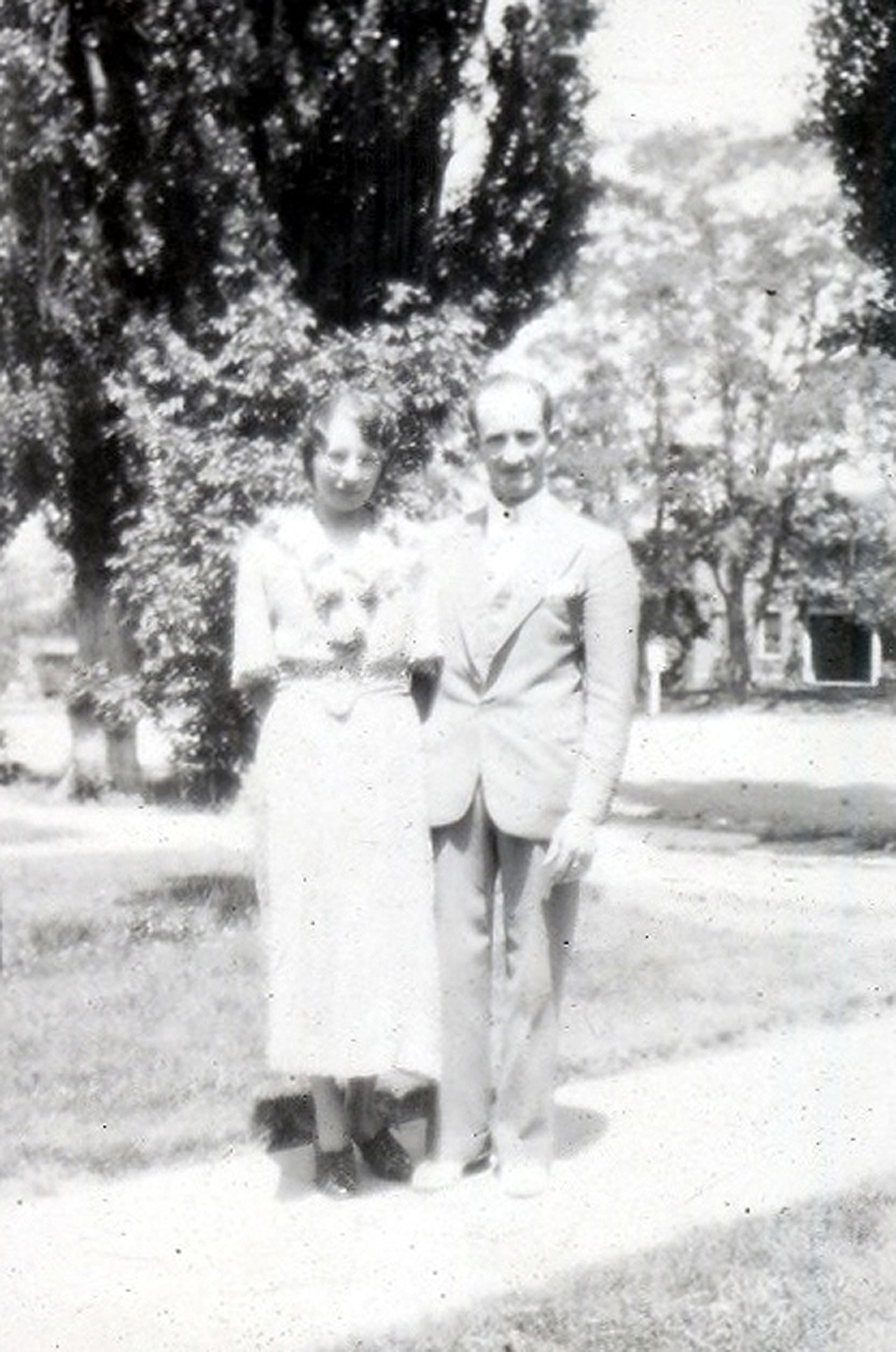

My father was Edward Loyn Blacker and my mother was Mabel May Brown. They were married in the Salt Lake Temple on October 9,1936. Since these were the only parents I had, I was not able to recognize or appreciate what truly great people they were.
I was born October 18,1937 in a two room house next to the one room Almy, Wyoming school where my father was the only teacher for all six grades.
I have only one memory of living in Almy and that is of walking away from the house and school and standing by the roadside and hearing a loud booming sound coming from somewhere. It frightened me and I ran back to the house.
My father moved to the Evanston Wyoming grade school in September of 1940 by moving the seven miles from Almy to Evanston.
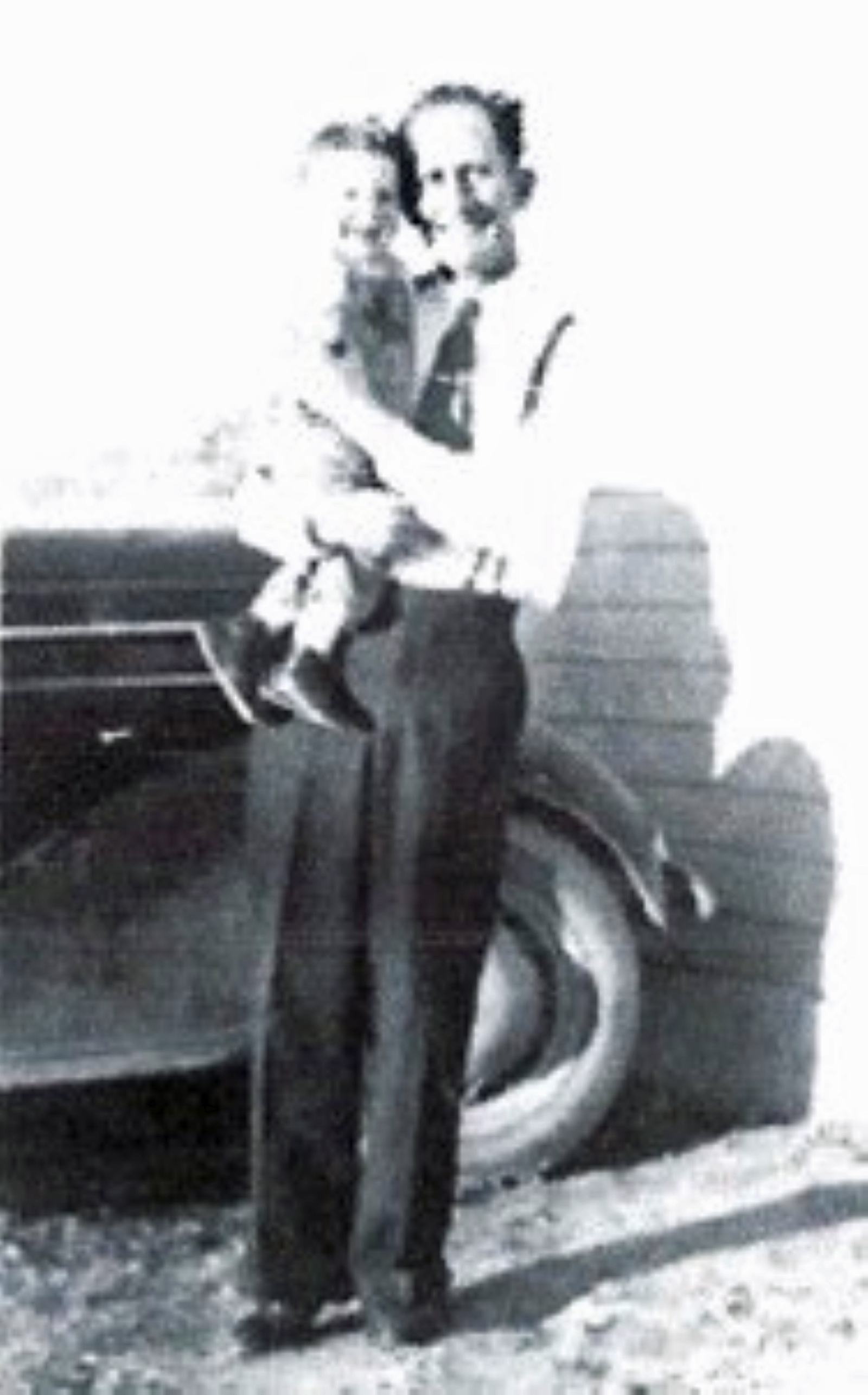
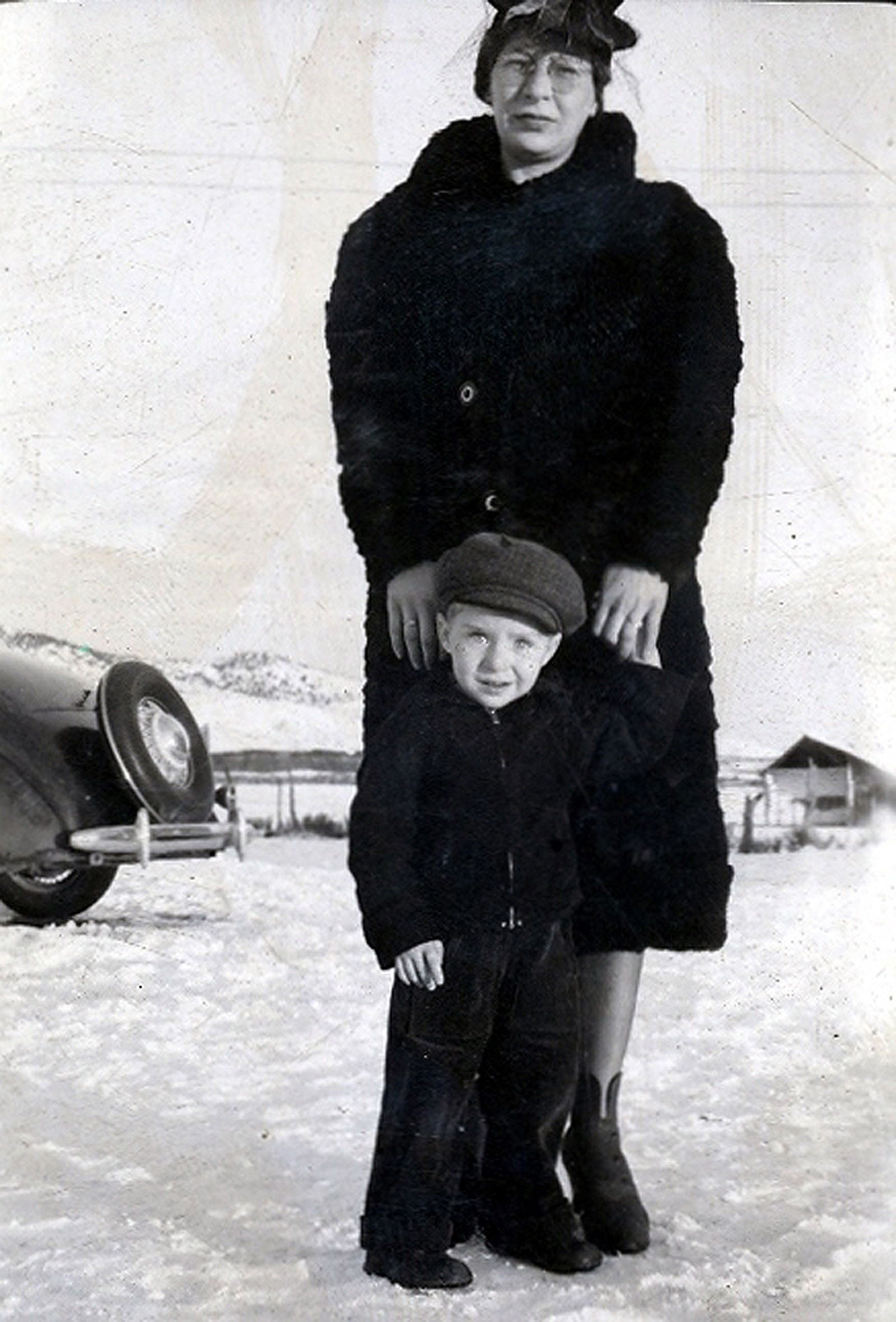
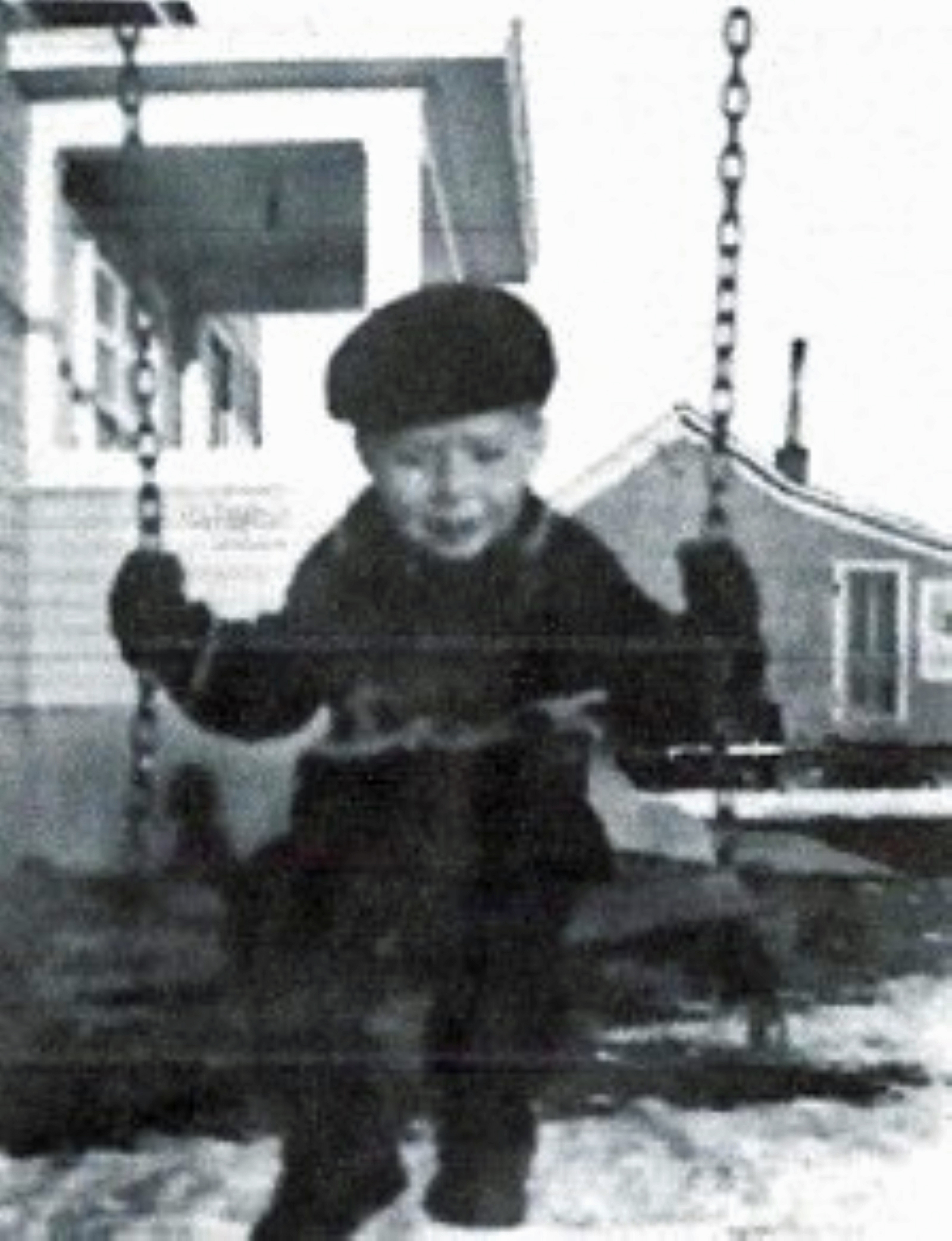
Our house was at 201 Front Street. The opposite side of the street was just open ground except for the Becker's Brewery that was the only structure in that area. The only other building on that side of the street was the State hospital facilities on the hill about a half-mile away.
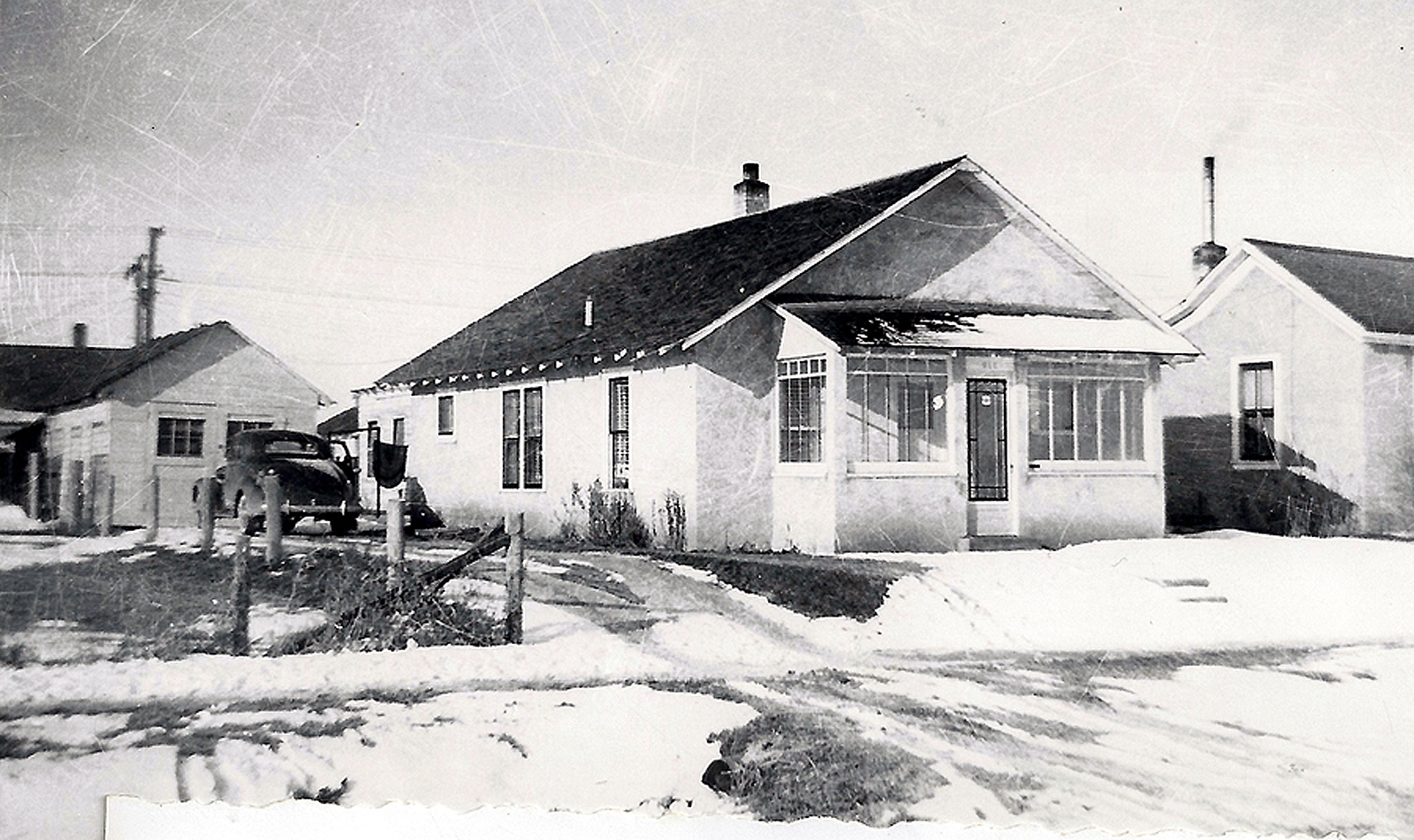
Dad taught school during the school year and worked at the Union Pacific railroad yard in the summer. I remember going with him to school on Saturdays where he would supervise the young men playing basketball. My sisters Ruth and Lois were born in our home there. I was four years old when the Japanese bombed Pearl Harbor and President Roosevelt declared war the following day on both Japan and Germany. I do not remember anything concerning December 7, 1941. But I remember people talking about the war. I do remember Dad taking me to a field some distance away from Evanston where we saw a bomber that for some reason had made an emergency landing. I remember Dad holding me up inside the open bomb-bay and I could look up forward into the cockpit.
Other memories include a neighbor girl my same age who had two thumbs on each hand. Mom told me that the doctor would remove the unwanted ones. I also remember playing with my cousin Bill, the son of Uncle Bill and Aunt Alice.
He made stick and tissue airplanes but wouldn't let me play with them because he was afraid I would break them.
In the summer of 1942 we moved to Rupert, Idaho. Dad took over the eighty acre farm owned by his father, Thomas Blacker, and he ran and managed the farm for three and a half years. Contrary to the few memories that I have of living in Almy or Evanston, I have many memories of events in Rupert.
It was a time of transition for American agriculture. We had a John Deere tractor but still used horses also for various farmwork. We harvested the grain with a binder and a belt driven thresher the first year but then Dad bought a tractor drawn combine to harvest with. We also grew hay for the cattle and horses and that was stacked into piles in the field by a horse-drawn dump rake and then the piles were loaded by pitch fork onto a wagon, carried the farmyard, and stacked by a derrick into a loose hay stack. The potatoes were dug by a horse-drawn digger and were picked up by hand by young and old into wire baskets and then the full baskets were dumped into burlap bags. The bags were then stacked and stored in the potato cellar until they were later sold to a dealer when the farmer thought the price was right. We had two Serge milking machines that were powered by a vacuum pump. We had no refrigerator and the kitchen stove and all heating in the house was fueled by coal. The telephone was a wall mounted, hand cranked machine with several different homes connected on the same line. The other parties could actually listen into your call if they wished. The phone call was placed by lifting the earpiece off the wall, cranking the handle a couple of times to alert the phone lady at "central" and you spoke to her and told her who you wanted to call. She then made the connection for you.
My sister, Mary, was born in that house.
I remember that during the harvest period Dad would drive the truck to the Minadoka County prisoner of war camp and we picked up a load of German and Italian prisoners of war who had been captured in Africa. Each load of prisoners was accompanied by an armed US soldier who made sure they were accounted for and were returned to their camp. I remember talking to a few of the prisoners who spoke English. I was riding with Dad one night when we returned a load of prisoners and Dad was slow at stopping at the Guard Station on the way out. The guard chastised Dad and told him that if he did not be more careful he could get shot. I remember being afraid because I did not want Dad to get shot.
One of our horses was named "Prince". One day Dad was plowing out a ditch that ran through the center of the farm and I was allowed to ride on the horse's back. While we were working in the ditch, something scared the horse and he jumped out of the ditch and ran at full speed back to the corral, pulling the plow behind him. He ran as fast as he could and I did the only thing I could do and hung on to the horns of the horse collar with all my might. Prince ran to the corral and stopped at the gate waiting to be let inside. Dad was even more terrified than I was and came running up to us a minute or so later. He lifted me down off the horse and hugged me. I asked him if that was as fast as the cowboys rode in the movies.
I started school in September of 1942 at the Pioneer elementary school about a mile and a half from our farm. Mrs. Sullivan was our first grade teacher and I was not a very good student. At my first report card Dad, a former school teacher, was absolutely humiliated by my grades. He expected far more from me than the grades revealed. I remember Dad initiating nightly homework immediately thereafter. And through it all I remained an average student all of the way through High School.
I remember Grandpa Blacker working in his garden. He asked me once to go and get him a glass of water. He said he was so thirsty he was about to choke. I had never heard that phrase before and I thought that it was a very odd way to say he was thirsty.
The war had a big influence on the type of toys I played with. I had a large four engine airplane that was one of my favorites. I also got a toy rifle shaped like an Army M-2 carbine. I also had a metal fighter plane with wings that folded up just like the ones on the aircraft carriers. I also remember getting sheets of thick paper with printed airplane parts that you punched out and then pieced them together to make mode airplanes that were supposed to fly but they never did. I also had a bow and some arrows. My cousins Leon and Royal and I tied Ruth to the telephone pole in the front yard and Mom caught us shooting arrows at her. Mom was upset. Ruth didn't seem to mind, and we never came close to hitting her.
Each night before we went to bed Mom would get a large spoonful of peanut butter and also put a large spoonful of honey on a plate. We would mix the peanut butter and honey together and then we would slowly eat the mixture with a piece of bread. Another favorite evening meal was bread and milk. Mom would warm milk in a pan and then pour it into bowls and put a small pat of butter in with the warm milk. We each got a slice of bread, sometimes toasted, and broke the bread up into small pieces and stirred them in with the milk and butter. We then enjoyed that as a meal.
Treats were a rare thing. Occasionally after church on Sunday, we would stop at a store on the square in Rupert and buy a quart carton of ice cream. We would take that home and enjoy it with dinner before it melted. Candy was also a rarity except for Christmas time when there was a bowl full of hard candy, nuts, and a few chocolates.
I especially remember the aircraft that flew around our area during the war. We could see whole flights of military aircraft formations. I could recognize P-38, P- 51, B-25, B-17, and the new B-29's.
I remember being in school in the spring of 1945 when the news was announced that the Germans had finally surrendered and that the war in Europe was over. All of the teachers were laughing and hugging each other.
Late that summer I can remember Dad telling us that President Truman had announced the new atomic bomb had been dropped on Japan. The announcement was made on August 6, 1945 and immediately news was broadcast to the nation. Dad was particularly impressed that one single bomb blew up an entire city. He also said that the war was over and the soldiers would be coming home soon.
In December 1945 we moved to a home on 1st Street in Ontario, Oregon. Dad and Mom loaded our furniture into the farm truck. I was impressed with the new home in the town that was very different from living in the country. I started school in the Ontario third grade after Christmas vacation. Miss Miller was my new teacher.
Our house was heated with an old convection style furnace in the basement fueled with sawdust that we bought from the sawmill in Payette. I could go down into the sawdust bin in the basement and play with our trucks and planes just as one would in a big sandbox.
The following summer, the circus came to town and I remember Dad came in one morning and woke me and I went down to the corner where the circus parade went to the bare alkali flats out by the fairgrounds. I sat on the curb as the wagons full of lions and tigers went by and also saw several elephants and other circus things pass by. It was quite a wonderful morning for a young kid. We lived about two blocks from the main Union Pacific train line and most of the trains were coal fired and carrying freight. There were two passenger diesel streamliners, however, that came through town, one about six in the morning and the other about 10 pm. They were named the Portland Rose, and The City of Portland. I loved to hear their mournful sounding air-horns as they came through town.
In late summer or early fall, we moved from our downtown home to our 10 acre homestead at the edge of town, out beyond the fairgrounds. The house was small wood frame with two bedrooms and a small living room and kitchen. It was heated with a convection oil stove in the living room. There was a corral and a barn and Dad bought a couple of cows to milk. We raised a beef but most of our meat came from chickens. We built a small coop and then Dad ordered fifty chicks that came in the US mail. We raised the chicks and after they were fully grown we would kill, pluck and clean about four or five each morning before school and Dad going to work. Mom would then dress them and then wrap them and then take them to the commercial frozen food locker that we had rented in town. We also had eggs from the laying hens.
We also had a large garden and several rows of raspberries and a row of currants. I learned to hate the raspberries because Mom made us get up about sunrise every other day and spend an hour picking berries. We also had several rows of strawberries. We planted enough potatoes, corn, tomatoes and squash so that we could feed the family without any additional purchases, and Mom cut corn off the cob and took those into the frozen food locker. We visited the locker about once a week and Mom would pick up the vegetables and chicken or beef that we would need.
We also planted several apple trees and a couple of peach trees on the side of our very expansive front lawn. Dad then put about nine of the ten acres into pasture. Mom put in a semi-circular flowerbed and everything except the garden was watered with flood irrigation. In the garden we used siphon tubes to irrigate the various rows of vegetables.
This house on the outskirts of Ontario was our home from 1946 when I was in the 4th grade until I graduated from Ontario High School in May 1955. Grade school and Jr. High were quite uneventful. It was in Jr. High School that Dad bought a saxophone and the lessons and band performances started me on my life-long interest in good music.
Church activities during these years included Primary, which I heartily hated until I graduated at the age of twelve. I then joined the Boy Scout troop and progressing through Tenderfoot and Second Class awards. We attended a Boy Scout camp one summer and we had multiple camping and fishing trips. After my second year in Boy Scouts the troop became fairly inactive. Initially, we had an exceiient scoutmaster, Brother Brad Tillotson, who organized and executed the scout program very successfully. But he died in a hunting accident in the third year and we never had a good scouting program after that. I lost interest in scouting and also in attending MIA about this time and even though I attended only because Dad said "We always attend our meetings" or "We always support the Church."
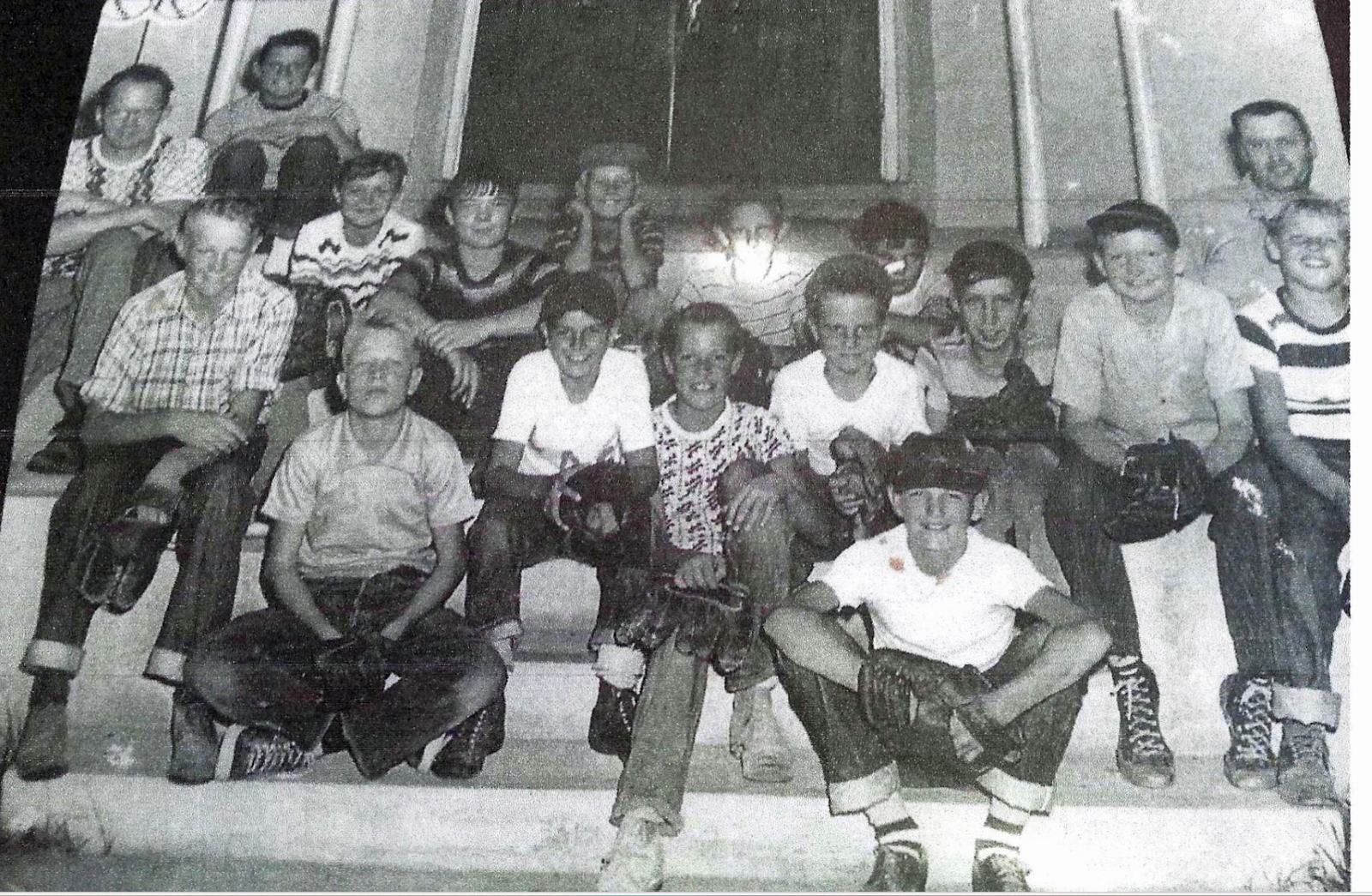
During my Aaronic Priesthood years I received seven individual awards for attendance - three of the five were for 100% attendance. I progressed through the Priesthood offices until I graduated from high school.
During high school I played in the marching and pep bands for the football and basketball seasons. I also played in the dance band. It was really quite a good band and I played lead saxophone for the school dances. I improved from being an average student to a better than average student but with still a very strong emphasis toward the average.
During the summers in high school I held a variety of summer jobs ranging from weeding onions, hoeing sugar beets, hauling hay, delivering furniture, and installing television antennae on rooftops. The summer after graduating from high school I worked nights at Ore-Ida frozen food company. All the while, I milked cows every morning and night.
Social activities included attending movies, high school events, running around with Bob Johnson, Kirk Williams, Jan Wynn, Bill Washburn, Roy Lee Tidwell, and a few others who were members of the ward. I only had one non-member friend and that was but our friendship gradually waned during the High School years. Then there were the monthly stake youth dances at the stake center in Nyssa, Oregon.
Once or twice a month a group of us would get a hamburger and milkshake from the Toot and Tell drive-in. The drive-in is long gone but was located just down the hill from hospital. The procedure was to drive into the parking lot, toot the car horn, and shortly an employee would come out and we would tell them what our order would be. They would hang a small tray on the driver's side door and then deliver the ordered food and drink. Occasionally we would also go to a drive-in movie theater that had spots to park the car and a nearby speaker on a cord that could be brought inside the car to provide the sound for the movie. We occasionally had two guys sit up front and buy tickets and had two or three more hiding in the trunk of the car. We would sneak in primarily for the fun of it. Once parked away from other cars, the guys in the trunk would sneak out and we would enjoy the movie. We thought we were so brilliant in being able to trick the owners by sneaking in, only to find out later that the management made most of their money from the concession stand.
Then there was always the weekly, 'Muchal' or more correctly pronounced 'Mutual', of the Church's Mutual Improvement Association. Scouting was to be the main activity for the young men, while the young women had their own set of courses.
Television came to the Boise and Ontario area in 1953. There were two stations in the Boise area that reached into the Ontario area if one had a large roof mounted antenna. Programs were broadcast two to three hours in the evening. Before then, the sole source of entertainment in the home came over the radio. I saw my first television program while on a trip to Portland, Oregon in early 1953. As Dad was in the furniture and appliance business, we had a TV set shortly after that time.
I graduated from Ontario High School, May 25, 1955 and applied for admission to Oregon State University where I had planned to major in pharmacy. But sometime during the summer, mother decided that I would go to BYU and she was very adamant about her decision. I accepted her decision and from 1955 until the spring of 1957 attended BYU.
Earlier in the spring of 1957, I was not accomplishing anything significant in education and decided to volunteer for the draft into the US Army. I received my draft notice and reported for service in July 1957 at the Army induction center in Boise, Idaho and then was sent to Army basic training in Fort Ord, California. After two weeks in Ft. Ord, many of the trainees were infected with an outbreak of meningitis and to protect the personnel we were assigned to finish our training at Ft. Lewis, Washington. This was my first plane ride on a DC-6 to the airfield at Ft. Lewis.
After completion of basic training, I was assigned to attend Army Administration Course in Ft. Leonard Wood, Missouri. On my way I was granted two weeks leave and stopped in Rupert, Idaho, where my parents had moved. After two months in Ft. Leonard Wood, I was assigned a permanent duty at the Army Medical Service School, in Ft. Sam Houston, San Antonio, Texas. I was trained as a Budget Clerk in the Office of the Comptroller. I spent the remainder of my two-year service responsibility in that position. Because the position required me to have access to sensitive information, concerning budget amounts and expenditures, I was granted a Secret security clearance. Then because of my Secret clearance, I was ordered to help part-time at another program at the Army Medical Service School, the nuclear weapons burn center, where I assisted with the packing and moving, storing boxes of secret nuclear effects data. This got me involved in the Army's nuclear testing program that was being conducted at the Nevada Test Center. I not only assisted in the safeguarding of nuclear data, but also because of my financial responsibilities in the Office of the Comptroller, was assigned to arrange travel and funding transfers for nuclear programs relating to the mission of the Army Medical Service School. Having this experience on my resume, allowed me entrance into various other nuclear programs later in my professional career.
But also in my regular duties as Chief Finance Clerk, it was determined that significant improvements had to be made to the financial record keeping in the Office of the Comptroller. This was thirty years before computerized accounting became a standard practice. The process that was imposed from Headquarters was a very complicated and difficult process. With my very simple double entry bookkeeping system that I was taught by Mr. Ludwig in my Ontario High School bookkeeping class, I was able to show several of my superiors how we could create a more direct and less complicated system for the Comptrollers Office. I showed this alternative to the Comptroller, who became a champion of the new process and I was able to get a few moments worth of recognition and it was accepted as a faster more efficient alternative to the process proposed by Headquarters.
Upon completing my two-year obligation, I returned home to Rupert, Idaho, in July 1959, where I did farm work and other jobs in agriculture. I was interviewed by the Bishop Nelson of the Rupert 2nd Ward and shortly thereafter, I received a mission call to the North Central States Mission. I entered the Mission Home in Salt Lake City in September, 1959, and after a week of training, was sent by train to the Mission Home in Minneapolis, Minnesota.
My first assignment was to Grand Forks, North Dakota. I spent three months there and then early in 1960, I was transferred to the Ft. Francis, Ontario, Canada branch where we worked both sides of the US/Canadian border. After a couple of months in Ft. Francis, we transferred to a very small town of Rainy River, Ontario. The town of Baudette, Minnesota was located just across the and during the warm seasons, the only access between the two was to walk across the railroad bridge. During the cold season, however, we simply drove across the ice of the frozen river. A customs office was located on the US side of the river and was manned year around although there was only foot-traffic across the bridge seven or eight months of the year. The huge Lake of the Woods was located a few miles further west.
A few miles north of Rainy River was located a small community called Bergland where the Church had a small branch of about 20 members, of about four or five families. As the missionaries, we were supposed to help the Branch President who had very little experience in leadership. Meetings were supposed to start at 9:00 am sharp and it was a constant irritation to Elder Jeppeson and me because members literally had no clocks or watches. Meetings started when members finished milking cows and eventually showed up. That was usually somewhere around 10:00 am. A couple of members lived across the river in Baudette, but tney never attended cnurcn because of the distance and difficulty getting to a branch. We never had any success in giving meetings or lessons to the non members of the area. Though missionaries had worked the area on and off for many years there was never a convert from the entire area.
I worked in that area until May, 1960 when I was transferred to the Winnipeg, Ontario branch. I worked there with Elder William Berrett whose father was a writer and educator of some note in the Church. We taught and baptized a husband, wife and two children during that time. In October, 1960 I was called as mission Secretary to President Child to keep track of the mission records and send periodic reports to Church headquarters.
While working as Mission Secretary, the Sisters working from the Mission Home were called to teach a young lady, Lynn Sprague, who had become interested in the Church. She committed to be baptized and since I was also in the Mission Home, President Hilton, the new Mission President, suggested that I baptize her. Shortly after her baptism, she moved to California, and as she was leaving I asked if I could write to her. This was how I met Lynn and we exchanged several letters during the remainder of my mission.
In the spring of 1961 I was assigned to a missionary area in South St. Paul, Minnesota where my companions were Elder Peacock and then Elder Smith. In September I was released and returned home by Greyhound bus to Rupert. I worked in the Paul, Idaho Amalgamated Sugar Plant during the autumn and winter and then returned to BYU during the spring of 1962.
I transferred to the University of Utah starting the autumn semester of 1963 there and also marrying Lynn Jeanine Sprague in the Logan Utah temple on August 30, 1963. We honeymooned in Yellowstone and Grand Teton Parks and then returned to Salt Lake City for work, university and married life. During this time I worked at various jobs as an attendant in gasoline stations, truck driver for a mink food production company, and as a part-time, door-to-door Fuller Brush salesman.
I graduated from the University of Utah with a Bachelor of Science degree from the Biology department in Zoology and Entomology in June of 1967. I applied for and was accepted into the Biology Graduate School program under the tutelage of Professor Frederick Evans. I continued with a full load of university classes, a full time job as service station attendant, and sometimes door-to-door salesman, until I was awarded a teaching fellowship in the Department of Biology in June, 1968. With the funds from the teaching fellowship, my Gl Bill education payments, and a part-time job working at the Metropolitan Water District laboratory, I was able to continue my education, and provide a subsistence level income for our family.
During my Master's Degree research I made a significant research breakthrough in the very small field of protozoology and was invited to present the results of my research at the International Protozoology Conference, sponsored by the Soviet Academy of Science, in Leningrad, USSR in July, 1969. Professor Evans, who had directed my research, offered to present my research results for me at that Conference. I was very proud of the achievement and thankful for Professor Evans' invitation. Upon telling Lynn about the honor, she said, "Why don't you present your own research?" Though she was recently pregnant with our first daughter Laura, she went back to work at the University of Utah Hospital in order to help pay for the additional expenses. The University paid for all travel within the US but they would not authorize foreign expenses. Through a compromise, they offered to pay the US portion of the travel and also the conference registration and fees but Lynn and I had to come up with the foreign travel and food and hotel. And both our parents were also helpful.
The trip to the Soviet Union was memorable and though our two countries were in the midst of a very antagonistic cold war, there were still some cultural and scientific exchanges occurring. It was a most memorable trip where after presenting the results of my research in Leningrad, I traveled on to Moscow, for a couple of days, and then on to the city of Irkutsk, near Lake Baikal, in Siberia. I attended the Limnological Institute on Lake Baikal and was very impressed with the biology of the largest body of freshwater in the world that had more endemic species than any other lake, and also with the results of some of the research going on at that facility. I was able to visit some important locations and also to attend performances both at the Boshoi and the Kirov Ballets and also to see a grand performance of Swan Lake performed in Irkutsk, Siberia. I was impressed with the fact that ordinary citizens were so drawn to the arts. I was also able to spend a day in the world famous Hermitage Art Museum in the Winter Palace in Leningrad (now St. Petersburg, again).
Another very impressive and depressive site was the visit to the War Memorial Cemetery in Leningrad where nearly half a million Russian civilians are buried who starved during the Battle of Leningrad after Leningrad was surrounded in the Summer of 1941 and finally broken in January of 1943. During that time nearly a million civilians died of starvation and disease in one of the most brutal modern sieges of a city. The Cemetery is a huge open field containing about 180 mass graves where nearly half a million Leningrad civilians are buried. I noticed that many of the Russians visiting were weeping. We noted that all of the German attendees at the Protozoology Conference spoke English while they were in area. It was extremely sobering to walk down the streets of Leningrad in 1969 and remember what had happened there 27 some years earlier when I was 4, 5, and 6 years old. And the Russian people had not forgotten what had happened and I am sure that it affects not only nationalistic feeling but also governmental and military policy even today.
While talking to some Russians I mentioned that the US was about to land a man on the moon, but they seemed totally uninterested, probably because they thought I was speaking propaganda. When our plane landed in Helsinki Finland on the way home, we saw that the newspaper headlines reported the successful landing and all of us were very happy.
In 1969 after six years with Cindy as our only child, another, Laura Lynn was born to our little family. A very alert and attentive child with dark hair and dark searching eyes seemed to miss nothing that was happening around her. We were very happy to have her as an answer to several years of sincere prayer. Upon returning to the University of Utah Biology department in Autumn, 1969, having had made a presentation at an international conference, I was able to obtain research funding to expand the research using electron microscopy examination of the protozoan.
In 1971 another daughter, Julie Ann came and she too was most welcome. Julie's personality was very feminine and her blond, nearly white hair made her very different than Laura.
In 1973 Jeffrey David was born and after three daughters, a son finally arrived and was a quiet well behaved child, a very handsome boy.
I completed my research in 1973 and wrote much of my Doctoral Dissertation by then but there was such a terrible job market that I, and also all of my peers, were unable to get jobs. I had a chance to continue as a research/teaching fellow for another year so I took that opportunity to feed and house my little family until the following year when I completed my Dissertation, passed my final oral and written exams, and was awarded my Doctoral Degree in December 1974. I was able to get a job with the Water Quality Division of the Utah State Health Division at a tremendous increase in salary - $13,500 per year. I began working there in January 1975. I was scheduled for official graduation from the University in March 1975 but was too busy to attend and the University mailed my graduation certificate to me shortly thereafter.
In 1975 James Darwin was born with a personality very different than his older brother. James was basically a louder child and was very ill early in his life with a serious congestion problem. We had to physically aspirate the mucus from his upper respiratory tract every couple of hours. Lynn took care of him during the day and did the best job of managing the other children also. It was my job to care for James during the night time and I never got more than an hour or two of sleep before having to care for him.
I worked for the Water Quality Division until 1978 when I went to work for a small Salt Lake City engineering consulting firm Vaughn Hansen Associates where I worked for about a year. It led to an increase in salary but I soon found it not to be a position that offered any additional opportunity. The senior scientist, my immediate boss, Welch, left and Dr. Hansen promoted me to Senior Scientist position, but shortly thereafter I was offered a position to develop a new environmental division at a large engineering consulting firm, Ford Bacon and Davis, located in the University of Utah Research Park and wisely moved there in 1979. My earlier army experience with nuclear programs played a large part in my selection for this position.
I hired a staff of environmental scientists to support the environmental and engineering projects of cleaning up mining and refining sites contaminated from uranium processing activities conducted years earlier. We also supported the environmental and engineering studies of former sites contaminated during the development of materials left during the processing and manufacturing of uranium for the development of atomic bombs during the 1940's through the 1960's.
Ford, Bacon and Davis received an unusual contract to work for the government of Morocco to design a 250 mega watt electric power plant that would directly burn raw oil shale. I needed to get a renewed passport very quickly so the company contacted our congressional office who put in an expedited request while I gave them my required information over the phone. Several days latter the passport showed up but along with it came a copy of my birth certificate issued by the State of Wyoming. It shows changes, first, with the name of Mom corrected from Mabie to Mabel, the place of birth was changed from Evanston to Almy, but my original name was Gordon B. Blacker. I remembered something that Mom had said about me originally being named Gordon but I had no other recollection.
In 1983, Dr. Vern Rogers, Director of all nuclear programs at Ford Bacon and Davis, left to start his own company and encouraged me to move to his new firm, which I did. I directed a very sensitive environmental impact statement for the new company, Rogers Associates, on the former Twin Cities Ammunition Depot just outside of Minneapolis. By late 1984, however it became apparent the new company would not be getting many environmental projects because Rogers Associates was more interested in serious nuclear projects for the US Nuclear Regulatory Commission so I went back to Ford Bacon and Davis.
FB&D began to have serious problems as engineering projects became harder to acquire and after several layoffs over the next year, I left FB&D in late 1988 to work on a massive and sensitive cleanup operation of the Weldon Spring Missouri Department of Energy facility. I was hired as the Environmental Protection Manager. We sold our home in Alpine Utah and moved to St. Charles Missouri. It was a difficult move for the family and after a little more than a year I decided that we had to move back and I was hired as an Environmental Manager at the Idaho National Engineering Laboratory in Idaho Falls.
We moved to Idaho Falls in January of 1990 and found a much more stable career and family situation. I worked on many different environmental programs there for the next eleven years until retirement in 2001. I also was offered a part time position as an Adjunct Faculty member at Idaho State University as the Laboratory and the University had joint training, education and research agreements. I taught evening classes for the University from 1992 until retirement in 2001.
We were quietly retired, living in Idaho Falls, until September of 2001 when the terrorist attacks of September 11 quickly brought a phone call from a former associate who we had worked together on nuclear programs but who a couple of years earlier had joined the Defense Threat Reduction Agency in Virginia. Immediately after that attack there was a massive reaction inside the Department of Defense for people who had experience in chemical, biological, and nuclear weapons. Dr. Clif Stine was asked if he knew of anyone with experience in any of these areas and responded that he knew a contact who had worked on all three. I was called out to interview with the Agency and they immediately started a process to have me transferred directly from Idaho State University where I was still listed on the Adjunct Faculty and loaned directly to the Federal Government and in that way, bypassing all of the complicated hiring processes. DTRA paid the University for my salary, with a healthy handling fee for the University, and they paid me, minus the healthy handling fee. The initial contract between DTRA and ISU was for one year but DTRA asked me to stay for another year and the University concurred. This happened two more times and I stayed with DTRA/ldaho State University for a total of 4 years. DTRA was staffed with about one half senior military personnel, Lt. Col or above, and about half senior civilian scientists from the National Labs, industry, or universities.
Lynn, joined me in Washington in 2003. We arrived in the DC area just hours before the 2003 hurricane hit the area. There was some damage to homes in the area although ours was not affected, but we were without electricity for a day or so.
We were members of the Falls Church, Virginia Ward of the McClane Stake. It was one of finest wards we had ever lived in and certainly the most diverse. Government workers from many nations lived in our ward and 17 different native languages were spoken. I served as Sunday School President for two years and Lynn had a special calling in helping various sisters in the ward.
My first two years with the Defense Threat Reduction Agency were the most enjoyable working year I ever had. I began as a Consulting Scientist, and after a year I was appointed Chief of the Scientific Programs of the Advanced Systems and Concepts Office. The staff I supervised varied in numbers as we were able to acquire or release back to other agencies as our project load changed.
As I first arrived, the major project for the agency was to find ways to protect against biological weapons as in late October 2002 there was an anthrax bacteria attack mailed to various governmental and press offices. The Agency advertised an appeal for proposals on how to detect anthrax contamination. The Agency was flooded with over 1,700 proposals from industry, universities, various labs, and even crack-pot 'off-the-street' responses that all had to be read and evaluated. Later in my tenure I managed projects to determine mutation rates of swine flu organisms as part of our biological weapons program.
I was also asked to help evaluate the potential for nuclear weapons use against the US by terrorists. We determined that there was a relatively low probability of weapons from enemy nations but there was a much higher probability for nuclear wastes or nuclear power reactors to be used as huge weapons of mass effect.
I also participated in preliminary studies for using computers to detect or to track terrorists. Again, as with the bio-weapons program, there were several hundred proposals asking for funding to detect or deter terrorist activities. We settled on only a handful from the National Labs, a couple of universities and a couple of private contractors.
My most enjoyable project, however was to work with the five uniformed academies and bring bright Cadets into our office every summer for a couple of months of hands on opportunities to tap into young and unconventional thinking of the Cadets. It was very rewarding to work with such eager bright young minds.
The first two years I was at DTRA were extremely enjoyable when professionals were in charge of the new organization. But by the end of the second year, the governmental professionals were starting to get control of the organization and by the beginning of the fourth year working conditions became almost intolerable. Government bureaucracy institutionalized all decision making to comply with the federal regulations of planning, budgeting, procurement. Programs that had become obvious that they would not work still had to be continued. New and innovative breakthroughs could not be exploited, and there was no longer any serious engineering or science to be conducted. I was turning 69 years old and Lynn and I decided to move back to Idaho.
We rented a house in Boise on a month-by-month basis and then bought our brand new dream home in Meridian in March of 2006. it is a lovely 1600 square foot open style living area, single floor home with a wonderful yard.
We are members of the Tully Park, Settler's Park Stake. We toured the new Meridian Idaho temple open house and also attended the dedicatory service and it was a very spiritual experience.
We try to visit the Oregon Coast and have found the town of Bandon, Oregon to be our favorite place. We rent a dwelling on the cliff above the beach and there is a very wide and long sandy coast for Skye to run along. The very stark rock pinnacles add to the beauty of the place.
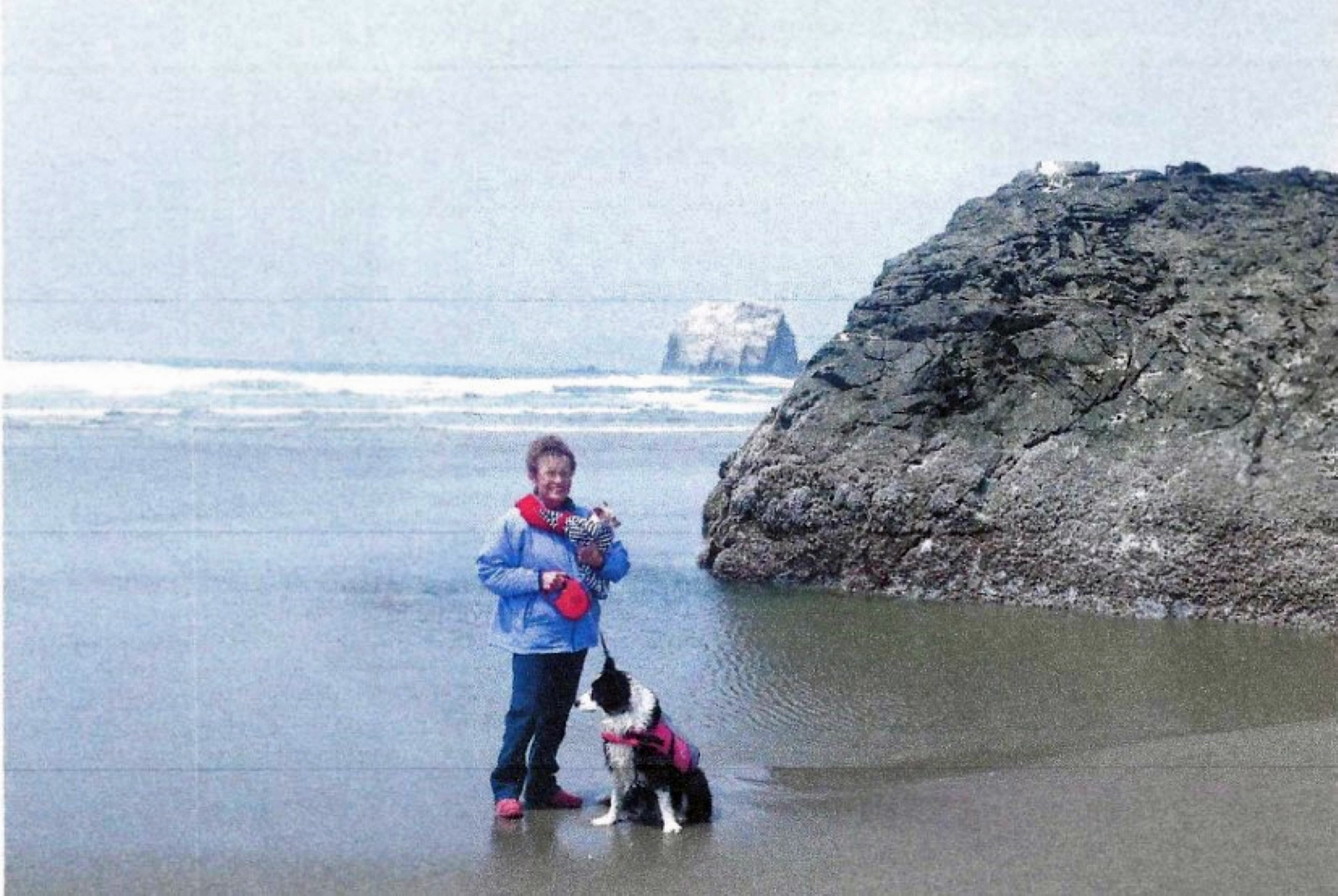
We both love the peace that we find with the surf blocking out almost all other sounds and we are especially happy to see Skye run and play in the surf and also chase the birds.
A Self Portrait
I think it's appropriate that I spend a little bit of time doing a self-assessment of my life. I think that I am in a position to do a fairly credible job on reviewing some of the accomplishments and some of the disappointments that I experienced.
Other members of my family will also be able to give a more objective evaluation but in reality I think I am probably in excellent position to do as well as any. Though I certainly would welcome any comments that anyone wishes to contribute.
I was fortunate to have good parents grew up in a good family with good siblings. I made some good choices concerning education, military service, mission service, and better than average career choices.
But clearly the most important event of my life was my marriage to Lynn. She's the most remarkable woman and we stood side by side through some serious and difficult times. Lesser women would not have done so.
I was blessed with six wonderful children one of which I intentionally chose, and five whom God was wise enough to bless me with. I am thrilled with how each of them has turned out and though I admit to making some mistakes raising them I am extremely happy with the way each has out.
I am a loner by nature that I somewhat ascribe this characteristic to my mother's side of the family. Peace to think, to ponder, to read great literature, to listen to great music, to marvel at the minds of men who gave us relativity, quantum theory, medicine, government, aircraft and microscopes and telescopes is important to me. Though I have spent a great deal of time alone, I have never experienced the feeling of loneliness.
I have interests across many fields but I am not particularly talented in any. I have always stood in awe of those who do have a great talent. I am stunned by Bach's Mass in B minor, by Einsteins two theories, by the thousands who who work at CERN and the thousands who run the telescopes. And if I have a talent it is probably the talent of being a generalist and having the ability to appreciate deeply many things that I am not quite capable of achieving myself.
I love the arts, painting and sculpture especially, as well as music the ballet, history, Science, and great literature.
I am devoutly spiritual but not terribly religious. I look back with regret on the thousands of hours of sheer boredom in church meetings.
I believe in God; a God who is magnificent glorious, capable and sovereign Beyond most of our abilities to even comprehend. I believe that the abilities that God possesses exist and are expressed in the form of nature, natural law, science. I believe god has revealed himself through revelation as to his prophets, from the scriptures that they wrote, and by revelation to ourselves through thought, introspection, meditation, and prayer.
I believe in Christ and I believe that he is the savior of this World but I am most impressed by the fact that he is the savior of me. I believe that Christ is a special incarnation, I believe that he is the son of God, and I believe that even though we are children of God the father, that Christ is no way our elder brother. To me, such a believe trivializes the magnificence of the Savior and what he accomplished and we improperly elevate humans far beyond what we're worthy of.
I believe in the Holy Ghost, I am able to quote Scriptures attempt to define him I have very little ability to comprehend him, his nature in his purpose.
I believe that Joseph Smith was a prophet for our time and probably the greatest prophet of all time. I believe that he must be considered either the greatest theologian in the last 2000 years, or else the greatest prophet of all time. The magnificence, the daring, the imagination, the sweep and the scope of his expansion of the existing Christianity qualifies him for such a title. One specific example is his proclamations in revelations concerning science in 1831 and 1842 stand alone and though these ideas were mocked for nearly a century until Albert Einstein prove certain elements of his revelations concerning the creation with his special and general laws of relativity.
REMEMBRANCES
At the conclusion of Dad's funeral I picked up one of the plants that graced the railing next to the pulpit and I took it home to Idaho Falls with me. It was a sort of living remembrance of Dad for me and I hoped to keep it for a while. I kept the plant alive at our home on Evergreen until we moved to Arlington, Virginia in 2003. In Virginia, the plant was placed on the back porch and allowed to grow all summer and then I took it into the kitchen and placed it in the window until the following spring when I put it back on the back porch. There the little six-inch tall potted plant grew to be over 16 feet long and it trailed over the banister of the porch and up over the top of the back door. When fall 2005 came I pruned the plant back to about an 8-10 inch plant and brought it back indoors in the kitchen window until I moved to Meridian in December of that year. I put it in the rear floor in front of the back seat but in the three-day trip to Meridian most of the foliage was frost killed because I did not take the plant into the motel with me at night. I thought that I had lost the plant after having kept it alive for 10 years but as a last resort I pruned it back to almost nothing but in the warmth of our Meridian home it reset foliage and grew back to a healthy plant. In the late winter of 2018, the plant seemed to die back. I pruned it and repotted it but it seemed that after 23 years it was about to die. I cut off two small leaves that looked most healthy and placed them in a glass of water to see if they would re-root, but though the leaves stayed green, there did not seem to be any roots developing. I got a small pot and filled it with fresh potting soil and stuck the green leaves in the soil and waited. After about six weeks I now see a small new leaf emerging right at the soil level. I am hopeful that I have been successful and the plant will take off again.
A Five Year Period of Stress
From 1983 through 1988 was a very troubling and turbulent time for me. I was employed by a company called Ford, Bacon and Davis that was an engineering consulting firm in Salt Lake City. We have been working on cleaning up uranium mill tailings, contaminated mine sites throughout the western United States and also working on formerly utilized site remediation projects for the Department of Energy. Ford, Bacon and Davis at that time had about 400 employees, I was the engine and I was the environmental Manager for those projects. That work came to an end and I could see that it was time for me to find another job at the very same time my boss Vernon Rogers opened his own radio active management company. I left Ford, Bacon and Davis and went to Rogers and Associates where I managed environmental impact statements for that company. It was only a small company of about 15 employees.
As I was leaving Ford, Bacon and Davis, that company was sued by a young minority employee who while being laid off with many others, claimed that he was fired because of his race. He named not only Ford, Bacon and Davis in the lawsuit but because I was his manager, I was also named in the suit and charged with discrimination against him. No, I had never done anything to hurt or hinder his employment with our company and even though he did not do exceptionally good work, we both left the company at the same time.
The human resources manager at Ford, Bacon and Davis told me that I had no right to have left the company and therefore I was on my own in the lawsuit. With no other recourse, I then called the Ford, Bacon and Davis attorney and told him I was being treated unjustly by the company, and then told him that I could just as well testify for the other guy or I could testify for the board of Ford Bacon and Davis.
I returned to Ford, Bacon and Davis in 1985. As the lawsuit had continued, there was really no productive work for me at that company, and I was assigned menial part-time tasks. My career was in limbo until the lawsuit would be settled, and I was not able to show any progress, growth, or productivity on my resume during that period of time.
It was during those years 1983 to 1988 that Lynn became increasingly ill and with the added anxiety of worrying for her health, worrying for my job, I went through a very stressful period of time.
I felt I was totally alone because of Lynn's health I was not able to bring up the very unpleasant and stressful subject of our situation to her. My company and its employees felt that I was only being tolerated by them until resolution of the lawsuit. I felt totally abandoned by my friends and church members during that time. The only good thing that occured during that period of time as far as I could see was the fact that since I was held captive at Ford, Bacon and Davis they were required to provide me with a small paycheck, much reduced from my previous glory days as a manager over 20 employees, but it was still something. But it was certainly not enough to care for all of our needs and wants during that time.
It was not until August 1988 that the lawsuit was resolved by paying a very small amount of money to the other employee while paying over $500,000.00 in inter companies fees for the extensive legal battle. I had previously submitted resumes throughout the US trying to get employment, but because partly of the lawsuit and partly because I had not produced anything of significant interest during the past five years, I had received no employment offers. I believe that significant background checks had shown that I was involved in a lawsuit and any conscious companies that would have been interested noted that, and passed me by.
Almost immediately after the resolution of the suit, I received an offer to become the environmental manager for a Department of Energy cleanup of contaminated sites at Weldons Springs, Missouri.
The Morning Ali Was Born
We were living in Alpine, Utah when Allison was born. Allison was kind enough to allow herself to be born at Lynn's convenience, and so when it came time for Allison to be born, we had made an appointment at the hospital in Murray, Utah for the profound event. Lynn was supposed to check in very early in the morning and that meant we had to arise very early in the morning. We couldn't leave the the boys at home so we took that along. It was still dark when I was taking Jeff and Jim out to the car and waiting for Lynn. In doing so we could hear the coyotes howling up on the hill behind our home. I wanted the others to hear this marvelous event also. I left the boys and ran back into the house to get Lynn and the girls. Jeff and Jim, seeing their dad run away, and thinking they had been left to be devoured by the ferocious beasts, started their own howling. I don't recall whether Lynn was able to make it out the house in time to hear the coyotes but I do recall Jeff and Jim certainly had a different perception of the event than I did.
Researching My Master's Thesis
It came time to write results of my research where I determined that stolmattal Genesis in the cyclomedium was greatly different from what had previously been described for the entire genus. All of the previous work had been done using a silver nitrate stain that didn't do an excellent job on identifying more of the various zones. In the preparation of the silver nitrate stains there was a certain amount of deformation in the cell. My instructor Professor Evans patiently explained the entire process. He then suggested I use a new stain called Pro tar goal, which still identified each of the kynetalsomes, but did not result in any deformation of the cell.
We tried this stain on a new cyclidium and were assured that the new process would not result in any deformation of the cell. Prof. Evans then instructed me to proceed and find the intermediale dividing cells, and put together the sequence that he felt was good match.
But as I found early dividing cells, I quickly determined that the process I had been instructed to use was not working. I went back to Dr. Evans with a few sketches of my early interpretations. He kindly suggested that I go back and do it over again.
I was able to find an excellent microscope in the department that had a camera attached so I could photograph the intermediale stages. I found that the redefining stages of the protozoa did not match what previous researchers had drawn out but had never before photographed. And it then took me another month or so of research to find enough dividing cells that I was able to piece together what I determined the correct division process. I then made an appointment with Prof. Evans and sat down with him to show the results not of drawings, but of actual photographs of the dividing stages. After I made my presentation, he asked me to go through the photographs again and explain them to him. I did so a second time and he just sat for quite a while looking over the photographs that I had taken.
Evans assured me that I did have indeed, a very respectable masters thesis and told me to get more photographs and then to write up the procedures and their conclusions into a draft of my thesis.
Writing The Final Draft of My Master's Thesis
After I had written several drafts in my masters thesis, and had Prof. Evans give his tentative approval to my research and to my conclusions, he suggested that I provide a final draft to Prof. Stephen Durant of the biology department, who had the reputation for writing and reviewing excellent scientific presentations.
I proudly took what I considered to be a pretty good draft to Prof. Durrant and came back a couple of days later after he had reviewed it, only to see it so covered with red ink, comments that it looked like he had bled all over it. He took quite a long period of time and walked me through each of his comments and made strong recommendations as to how I needed to rephrase my writings, and also how to include certain pieces of data that I had not thought necessary and had left out of my final discussion.
It took me a couple of months to rethink, rewrite and to retype the facts in a respectable format. This was difficult because the university allowed no typos or over strikes in the final document.
After completing the changes I took the revised copy to Prof. Durrant who very critically went over the draft and pointed out where I needed to expand my writings. He criticized the work for not having adequately included the changes that he had first been suggested that I make. With all of the other things going on in my life the subsequent rewrite took another month or so to get it done in a manner that I thought sufficient and turn the copy into him. By this time I felt quite angry towards the professor and felt the the work I had done was more than sufficient. But having turned in the new draft, we made an appointment for me to stop by a week or so later after he had a chance to again review the document.
I came back at the appointed time and Prof. Durrant was on the telephone, but waved me into his office and motioned for me to sit down. I could see my draft thesis on the corner of his desk and I could see that there was not a single spot on it, and I knew that he had not had a chance to review my document and I was upset to the point of almost being furious with him.
It took him a few minutes to finish the telephone call, and all that time I sat there stewing in my anger, and when he finished the call he reached over and picked up my thesis and tossed it towards me and said, "Blacker, you have a piece of science here that you can be proud for the rest of your life." My anger immediately turn to shame. I almost broke down and cried for the released attention I was under, but more so for the fact that a very hard nosed professor with the strict reputation for scientific excellence had approved the work I had done.
Chief Jim Horton
While I was in Fort Frances, Canada working with Elder Jepson, we traveled far north on Lake of the Woods to an Indian Reservation that missionaries periodically visited. We were met by the chief of the tribe, Chief Jim Horton, who welcomed us warmly. He took us into his office and went to a cupboard and brought out a copy of the Book of Mormon that he had been given many years earlier. And he bore his testimony to us that this was a history of his people. He gave such a strong testimony and I immediately had visions of converting the entire tribe to the church. As we started to try set up some meetings however, it became clear that chief had little interest in having missionaries come and teach. He finally made it clear that though this was a history of his people and he knew that it was a true history they were waiting for his people to come and bring the true gospel to the tribe. He then told us that they were of the tribe of Israel. Missionaries of his own people would come and bring the truth to them. I have come to suspect that the gathering we are doing in the church today is primarily bringing converted gentiles to be grafted in and that the activation of the true vine will be done by missionaries specifically from the tribe of Joseph. In spite of a tremendous effort that the church has spent on taking the gospel to the Indian people I believe that we have had had relatively little success and that there is a very fundamental reason for that lack of success. It appears to me that there is a gap existing right now between the promise of the Book of Mormon where the Gentiles will bring the gospel to the Lamanites versus what the Lamanites themselves are expecting at this present time.
Jeff's First Fish
I remember we had been fishing at Mirror Lake in Utah. Jeff who was just barely walking must've been two years old, caught his first fish. I tried to take the fish off the hook but Jeff claimed it was his. He carried it for a while and then began dragging it while while it was still hooked everywhere he went. After a while the fish started drying out and it dirty and muddy and the temperature was fairly warm. It has not been cleaned so we decided to just let him drag around. On the way home we stopped at a grocery store and bought a fish and then took that home and cooked it.
Sixty-Three Years Without Milking a Cow
It is now over 69 years since the windy September morning in 1955 when I milked my last cow and left the barnyard for the University. 69 years since the avenging angel Gabriel came down from the heavens and broke the chains and shackles and hobbles, and freed me from a life of misery from the twice daily regimen of enforced cow milking. I have long thought that the cow is the symbol for the very devil himself. A creature with cloven hooves, pointed black horns on its head, a long tail, and breath caused by the stench of trillions bacteria rotting fetid food deep inside its foul bowels. A creature whose very being causes hate, discontent, anger, and profanity. And I'm not talking about Satan.
The Most Beautiful Girl
While on my mission in 1960,1 was the Mission Secretary and one afternoon I was assigned to drive to pick up the Sister Missionaries who were teaching one of their contacts. As I drove up to the house located at 3642 Russell Avenue North, in Minneapolis, the Sisters came out and stood on the porch of the house talking with an extremely attractive young woman. Several weeks later the Sisters had prepared the woman for baptism, and as I was permanently attached to the Mission Home, President Hilton assigned me to baptize and confirm her. Shortly afterward, she moved to California and since she would no longer be in our mission I asked if I might write to her. She said yes. Three years later we were married in the Logan Temple and have remained married for over 60 years.
Solemn Assemblies in the Salt Lake Temple
I have attended two different solemn assemblies in the upper assembly room of the Salt Lake Temple. The first one happened when the University of Utah Institute program arranged such a program for their returned missionaries. President Harold B Lee was the main speaker. It was a special event for me and it was a very spiritual occurrence. The second Assembly occurred in 1976 and President Kimball was the main speaker. This assembly was called for bishoprics in our specific region. Both Presidents spoke on the responsibilities of the priesthood holder. I was struck by the size of the assembly room that seemed to stretch the entire length of the temple, although I may be wrong on that point. There was the Pulpit for the Melchizedek Priesthood on the east end of the room and a similar one for the Aaronic Priesthood on the west end.
Mormon Scriptures in Muslim Country
I am one of a few people who has taken scriptures into a Muslim country. In 1983 I was sent by my company to the country of Morocco to evaluate building an oil shale fired electricity plant. Having no knowledge of the Muslim restriction against bringing scriptures of other religions into their country, and knowing that I would be there for a couple of weeks, I took my scriptures along with me, consisting of the Bible and the four Mormon standard works. In going through customs in Morocco the agent immediately spotted my two volumes and reached down and picked them up and started thumbing through them. He said, I cannot allow you to bring these into this country as religious materials. But he continued thumbing through my volumes and looking at them. Finally he said, "I see that you do not consider these to be religious materials. I noticed that you are a scholar with the doctorate degree, therefore I deem these to be research materials. Then he said, "A religious man would never desecrate the Holy Scriptures by writing and underlining in them." Things are very different today and I'm very sure that no one can do this now.
The Day I Bought My Gun
The day I bought my first gun was one of the happiest and then most distressing days of my life until then. I really wanted to buy a gun. In October of my 16th year shortly after my birthday, I had saved up enough money, $63 if I remember right, from picking corn and doing other fieldwork. I went down to the sporting goods store on Main Street in Ontario and bought a brand-new Remington Wingmaster 12 gauge shotgun. This was the culmination of my dream for the past many months and I was very happy. When I walked in the house carrying my prized possession, Mom just exploded in anger and rage. I had seldom seen her that upset. She accused me of wasting money on something that I did not need. Many years later I can recognize the fact they were probably in serious financial problems. I think she also was worried about the safety factor of a young kid running around with the firearm. So one of the happiest days of my entire life to that point turn into a very distressing day and week and maybe longer.
| PAUL B. BLACKER, Ph.D. | RESUME | 5312 N 5th Street |
| Arlington, VA | ||
| 703-767-4453 or paul.blacker@dtra.mil Work | ||
| 703-946-5083 or paul.blacker@comcast.net Home | ||
6-2004 to 12-2005: Chief, Science and Technology Division, Advanced Systems and Concepts Office, Defense Threat Reduction Agency. Twenty years experience developing technologies for projects having sensitive environmental, economic, and defense impacts. DOD Top Secret Security Clearance. Extensive education and publication credentials, strong technology development and implementation record, and R&D experience.
1-2002 to 6-2004: DTRA Advanced Systems and Concepts Office, Ft. Belvoir, VA. Advisory Scientist - Directed projects in DOD think-tank to safeguard
1992 to 2005 Adjunct Professor, Idaho State University (ISU). Inter-Agency Position Assignment (IPA) supporting DOD programs
| EDUCATION: |
B.S. Zoology and Entomology, 1967
M.S. Environmental Biology, 1969 Ph.D. Biology, University of Utah, 1975 120 hr Entrepreneur Course, Harvard faculty |
| MISC: Member; |
Project Management Institute, National and Local Chapters
Idaho Chapter of American Nuclear Society. |
| Honors; | Phi Sigma, National Honors Society for Excellence in Biological Research. Made presentations to U.S. National Academy of Science and Soviet Academy of Science. |
| Former Clients | Bechtel, Sandia National Laboratory, Army Corps of Engineers, Amoco, Standard Oil of Ohio, Honeywell, Rockwell, EPRI, Kennecott, Southern Pacific, National Lead of Ohio, Moroccan Government, DuPont, DOE Labs. |
Publications, Papers, and Reports; - Specific titles attached.
PROFESSIONAL
EXPERIENCE:
7-04 to Present: Science and Technology Division, DTRA
Development of innovative and advanced technologies to defeat weapons of mass destruction. Focused on nuclear, chemical, biological and policy issues concerned with highly innovative advanced technologies and systems in 3-20 year future. Discussed technology requirements from DOD and governmental agencies and coordinated research and conceptual development with various technology, system and policy providers. Coordinated think-tank activities of DTRA with Combat Commanders, National Laboratories, universities, other government agencies and industry.
nation against weapons of mass destruction (WMD). Coordinating terrorism studies with DOD War Colleges and military academies, Leader of the DTRA Threat Anticipation Program coordinating the development of computerized anti-terrorism models. Established a Threat Anticipation discipline program with University of Chicago/Argonne National Laboratory. Evaluated threat scenarios against shipments of spent nuclear fuel.
1-90 to 6-01: Idaho National Engineering and Environmental Laboratory, Idaho Falls
Advisory Scientist - Developed hydrogen gas generation measurement equipment and procedures to ship 3100m3 of INEEL's TRU waste drums to WIPP. Achieved milestones and acceptance of procedures and equipment by Carlsbad DOE Office. Guided 25 environmental technologies for DOE Headquarters' Accelerated Site Technology Deployment program. Managed 4 classified and technically complex DP Surety projects developing plutonium technologies at Los Alamos National Laboratory. Managed research project on Pentaborane uses for Secretary of Energy in the DOE/Lockheed Pollution Prevention Technologies programs: completed project ahead of schedule and under budget and received favorable mention on LM1TC0 CPAF. Assisted cleanup of radioactive lead materials. Received a DOE grant to develop a data management computer template for planning and control of environmental data. Managed a joint DOE/US Air Force Memorandum of Understanding coordinating development of pollution control technologies. Awarded and managed an FY-94 DOE Laboratory Directed Research and Development grant to develop a computer based expedited Superfund CERCLA management process. Integrated team member implementing an INEL-wide program to support DoD military base closure environmental support. Developed total-cycle RCRA Corrective Measures cleanup project baselines and management process for 20 EM-30 and EM-40 projects for Argonne National Laboratories. Team-developed a process ensuring regulatory compliance for the INEL Buried Waste Integrated Demonstration projects. Coordinated University and ER/WM educational affairs at the INEL. Managed $14 million CERCLA, FFA/COCA activities for the mixed waste Radioactive Waste Management Complex at the INEL. Presented INEL remediation plans to the National Academy of Science.
9-88 to 1-90: JACOBS/MK FERGUSON ENGINEERING, Weldon Springs, MO.
Environmental Protection Manager - Directed environmental protection programs at Weldon Springs Mo., a DOE mixed waste Superfund site. Key contributor to Rl/FS and EIS process. Planned and implemented sensitive environmental monitoring programs, wrote annual monitoring reports. Directed 10-person professional staff with routine and special monitoring and analysis activities to determine contaminants of concern, extent of contamination. Managed extensive data sampling, analysis, and validation task. Received extensive public participation training and experience.
1-85 to 9-88: Ford, BACON AND DAVIS, Salt Lake City, UT.
Environmental Manager- Directed a Defense Environmental Restoration project under contract to the US Army Corps of Engineers, Huntsville, for a hazardous and toxic investigation of a former Army ordnance facility. Developed a strategy for stabilization of RCRA wastes at 4 major Amoco Refineries. Directed RCRA Permitting activities for siting hazardous waste incinerators.
5-83 to 9-88: ROGERS & ASSOCIATES ENGINEERING COMPANY, Salt Lake City, UT.
Environmental Manager - Directed NEPA activities for ecology portion of an EIS for a major defense contractor. Developed an environmental strategy to accommodate a threatened species at the site. Designed and executed a study of potential vegetation uptake of uranium and other heavy metals. Completed a "lessons-learned" review of the Texas Low-Level Waste siting program for the Electric Power Research Institute. Worked under contract to the Utah Governor's Office to review the NEPA process for a high-level nuclear waste facility in Utah. Defined site selection criteria and alternatives for a radiologically and chemically contaminated 3 million yard phosphogypsum process waste pile.
2-79 to 5-83: FORD, BACON & DAVIS, Salt Lake City, UT.
Manager Environmental Programs - Managed the RCRA Part A&B permit applications for two in-situ oil shale facilities in Utah. Directed complex program of NEPA EAs for 14 abandoned DOE Uranium Mill Tailings (UMTRAPJ sites. Supervised environmental analysis of a proposed oil shale fired power plant in Africa for the Government of Morocco. Directed the NEPA environmental/ engineering assessments for remedial actions at five DOE Formerly Utilized Site Remediation (FUSRAP) sites. Proposed management alternatives for defense wastes at the DOE Hanford site for 21 disposal alternatives. Developed environmental strategy for Southern Pacific compliance with US Corps of Engineers Section 404 Wetlands regulations.
11-77 to 2-79: VAUGHN HANSEN ASSOCIATES, Salt Lake City, UT.
Environmental Scientist - Developed CWA Section 208 Water Quality Management Plans for two Associations of Governments. Served as environmental consultant to the Utah Division of Great Salt Lake.
1-75 to 11-77: UTAH STATE DIVISION ENVIRONMENTAL HEALTH, Salt Lake City, UT.
Environmental Health Scientist - Authored Utah's Annual Water Quality Report to Congress for 1975 and 1976. Team wrote the 1977 major revision of the Utah State Water Quality Standards. Key contributor to Utah's continuing planning process for water quality programs.
6-69 to 1-75: METROPOLITAN WATER DISTRICT, Salt Lake City, UT.
Microbiologist and Chemist - Performed physical, chemical and biological tests.
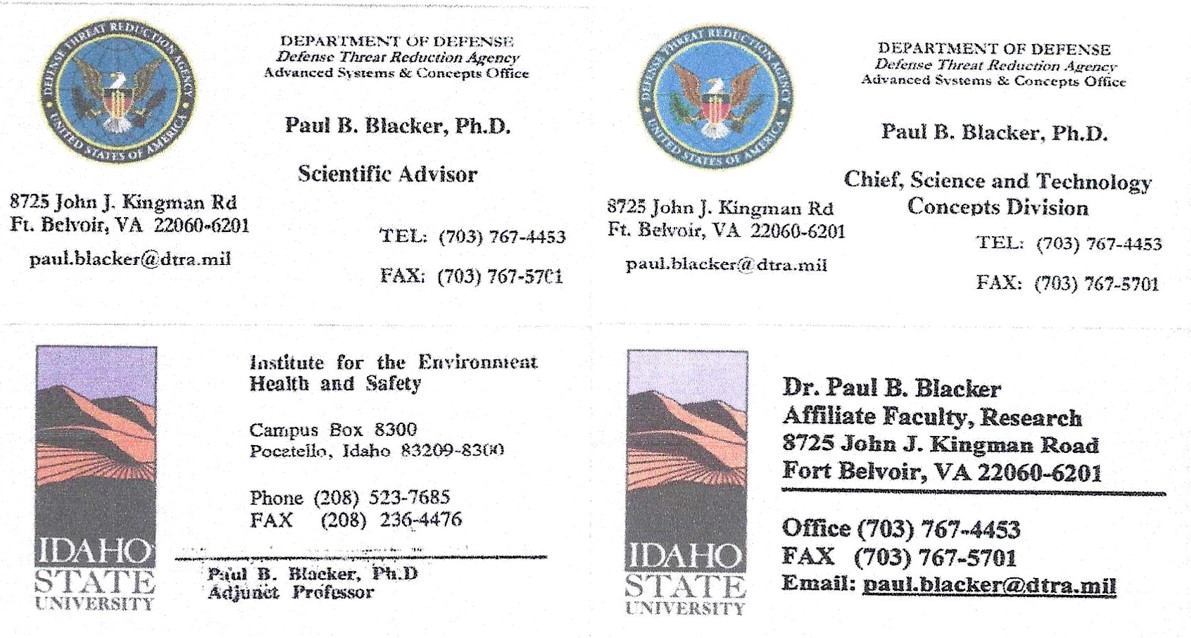
PAUL B. BLACKER, Ph.D.
PUBLICATIONS. PAPERS. AND PROFESSIONAL DOCUMENTS
Blacker, P.B., 2018, "An Idaho Nuclear Fantasy," 60th Idaho Academy of Science and Engineering Symposium and Annual Meeting. Apr. 21, 2018, Boise State University.
Blacker, P.B., 2014, "Idaho's Rejuvenation of the Nuclear Industry." 56th Idaho Academy of Science Annual Meeting and Engineering Symposium. Mar. 21, 2014, University of Idaho.
Blacker, P.B., 2005, "Massive Dirty Bombs Using Spent Nuclear Fuel Shipments." Defense Threat Reduction Agency Working Paper, Advanced Systems and Concepts Office. Ft. Belvour, VA.
Blacker, P.B., 2004, "Commercial Power Reactors as Potential Massive Weapons of Mass Destruction," Defense Threat Reduction Agency Concept Paper, Advanced System and Concepts Office. Ft. Belvour, VA.
Raskie, M., P.B. Blacker, 2003, "Identifying and Reducing the Threat of a Terrorist Attack on Spent Nuclear Fuel Shipments." Defense Threat Reduction Agency, Advanced Systems and Concepts Office, July 28, 2003.
Blacker, P.B., 2002, "Analysis of Potential Use of Explosive Shaped Charges by Terrorists." Defense Threat Reduction Agency, Advanced Systems and Concepts Office Working Paper, Ft. Belvour, VA.
Stine, C.E., P.B. Blacker, 1999, "Waste Assay for Non-Radioactive Disposal (WAND]" American Chemical Society, El Paso, TX Oct 22,1999.
Winston, R.A., P.B. Blacker, 1999, "Communication in a Classified Environment: I'm Sorry, You Have No Need to Know." Project Management Institute, Government Section, October 11-13,1999, Philadelphia, PA.
Fix, N.J., G.L. Schwendiman, R.A. Larson, P.B. Blacker, J.T. Brown, 1999. Statement of Work for the Commercial Dismantlement and Radioactive Decontamination of Lead Shielded Casks," Lockheed Martin Idaho Technologies Company. INEEL/EXT-99-00337, for Idaho National Engineering and Environmental Laboratory.
Blacker, P.B. 1998 (Invitation to Present] "A Total-Cycle Environmental Program Management and Control System." Project Management Institute Conference, PM1 Asia, Manila, Philippines. January 1999.
Leatherman, G.L., P.B. Blacker, and C.P. Ischay, 1998, "DP45 Fiscal Year 1998 Year- end Report," Lockheed Martin Idaho Technologies Company," INEEL/EXT- 98-00988. Report for Idaho National Engineering and Environmental Laboratory.
Blacker, P.B., 1998, "Status of Hydrogen Generation Developments at Los Alamos, INEEL, and Rocky Flats," Report for Los Alamos National Laboratory Plutonium Production Facility. Final Deliverable for DP Surety Program Project.
Bates, S.O., P.B. Blacker, et. Al., 1998, Final Design Report for DOE's Defense Program Surety Vitrification System." Lockheed Martin Idaho Technologies Company, INEEL/EXT-98-00916, Report for Los Alamos National Laboratory.
Blacker, P.B., and R.A. Winston, 1997, "Integration of Project Management and Systems Engineering: Tools for a Total-Cycle Environemtnal Management Syste," Project Management Institute-97, September 1997, Published in Proceedings: PMI-97.
Blacker, P.B., 1996, "Pentaborane Conversion Analysis." A Report for the Secretary of Energy. Polution Prevention Technologies Department, Lockheed Martin Idaho Technologies Company, 1 NEL-96-0339, September 1996.
McAtee, R.E. and P.B. Blacker, 1996 "An Evaluation of the Intellectual Property and Patent Status of Cobalt Dicarbollide," A Lockheed Martin Internal Report, Pollution Prevention Technologies Department, August 1996.
Blacker, P.B. 1994, New Process for Total-Cycle Management of Environmental Cleanups," Paper presented at Third EG&G GOCO Environmenental Conference, Sponsored by EG&G, Las Vegas, Nevada, May 10-12,1994.
Blacker, P.B. 1994, Buried Waste Integrated Demonstration Technology Preparedness and Status Report Guidance, EG&G Idaho, Inc., Report for DOE, Technical Publication, EGG-WTD10266, Rev. 1., April, 1994.
Blacker, P.B., 1993, "Project Management and Research in a Single University, Multi- Disciplinary Waste Management Program," Proceedings of the Fourth Annual Conference, Alliance of Universities for Democracy, Nov. 11,1993, Budapest, Hungary, Sponsored by University of Tennessee.
Blacker, P.B., 1993, Environmental Project Managers Need Education in Projecdt Management Skills," Proceedings of the 1993 International Waste Management Conference, Sponsored by EPA, DOE, Universidad del Turabo, April, 1993, San Juan, Puerto Rico.
Patricia Cannon, Larry Watson, Paul Blacker, 1992," A Process for Ensuring Regulatory Compliance at the INEL's Buried Waste Integrated Demonstration Project, " Proceeding of the 14th Annual Department of Energy Low-level Radioactive Waste Management Conference, Phoenix, AZ, November 1992.
Blacker, P.B., Patricia Cannon, and Larry Watson, 1992, "Buried Waste Integrated Demonstration Technology Preparedness and Status Report Guidance." Report for DOE, prepared by EG&G Idaho, Inc., WTD=10266, June 1992.
Blacker, P.B., 1991, "Development of a Paradigm for Environmental restoration and Waste Management Education and Training Needs," Drafted for DOE Headquarters, Office of EM-50.
Blacker, P.B., Kenneth Meyer, et.al., 1989, "Annual Environmental Monitoring Report, 1988, for the Weldon Spring Site Remedial Action Project, Weldon Spring Missouri, "Rev 0, DOE/OR/21548-078, Report for DOE Prepared by MK-Ferguson Company and Jacobs Engineering Group, Weldon Spring, MO.
Lusk, M. and P.B. Blacker, 1989, "Radiological and Chemical Uptake by Edible Portions of Select Biota at the Weldon Spring Site," Rev 1, D0E/0R/21548- 044, Report for DOE prepared by MK-Ferguson Company and Jacobs Engineering Group, Weldon Spring, MO.
Blacker, P.B., 1988, "Asbestos Sampling and Analysis Protocols for Buildings at the Tooele Army Ordnance Depot," Report for US Army, Tooele Army Ordnance Depot, by Ford, Bacon, Davis, SLC, Ut.
Taggart, G, and P.B. Blacker, 1988, "Review of Alternative Methods for Stabilization, Destruction and/or Disposal of Organic Process Wastes for Four Petroleum Refineries," Report for Amoco Refining Company By Ford, Bacon and Davis, Dallas, TX.
Blacker, P.B., 1988, "Permitting Strategy for Alternative Uses of Fly Ash and Sedimentation Basin Sludges From Coal-Fired Power Plants," Report for Confidential Client by Ford Bacon and Davis, Dallas, TX.
Blacker, P.B., 1987, "Evaluation of Potential Contamination of Hazardous, Toxic and Explosive Wastes at the Former Denver Ammunition Plan." Report for US Army Corps of Engineers, Huntsville Division, From Ford, Bacon and Davis, SLC, UT.
Blacker, P.B., 1986, "Hazardous and Toxic Waste Pedrmitting Strategy for a Coal Liquifaction Pilot Facility:, Report for Eyering Research Institute from Ford, Bacon and Davis, SLC., UT.
Baird, R.D., and B. B. Blacker, 1985, "Siting Controversial Facilities," Proceedings of the 7th Symposium on Management of Uranium Mill Tailings and Hazardous Wastes, Colorado State University, Boulder, CO.
Blacker, P.B., 1985, "Environmental Assessment, Fatal Flaw Analysis, Permitting Requirements and Exploration Permits," Report for Sohio from Ford, Bacon and Davis, SLC., Ut.
Blacker, P.B., 1984 "Peer Review Summary of Comments of the Utah High-Level Nuclear Waste Site Selection Process," Report for the Utah Governor's Office, Rogers and Associates, SLC., Ut.
Blacker, P.B., A. Sutherland, 1984, "Review of the Texas Low-Level Nuclear Waste Site Selection Process," Report for the Electric Power Research Institute, Rogers and Associates, SLC., UT.
Rogers, V., and P. B. Blacker, 1984, "Disposal Site Selection Criteria and Siting Process for Phosphogypsum Process Wastes," Report for Amoco from Rogers and Associates, SLC., UT.
Blacker, P.B., and D. Bernhardt, 1983, "Laboratory Uptake of Oxidized Uranium by Selected Plant Species," Report for Honeywell by Rogers and Associates, SLC., UT.
Bernhard, D., and P.B. Blacker, 1983, "Environmental Impact Assessment of Proposed Uranium Incineration Facility at the Twin Cities Army Ammunition Plant," Report for Honeywell by Rogers and Associates, SLC., UT.
Keithley, J.J., P.B. Blacker, et. al., 1982., "Environmental Assessment of Remedial Action at Middlesex, N.J.," Report for US Department of Energy, Ford, Bacon and Davis, SLC., Ut.
Keithley, J.J., P.B. Blacker, et. al.,1981, "Environmental and Engineering Assessment of Low-Level Contamination at Former MED/AEC Sites," (Series of five separate reports for US. Department of Energy), Ford, Bacon and Davis, SLC., UT.
Weyman, G., P.B. Blacker, et al., 1980, Alternatives for Long-term Management of Defense Transuranic Low-Level Nuclear Waste at the Hanford Site, Richland, Washington," Report for Rockwell from Ford, Bacon and Davis, SLC., UT.
Hill, F., P.B. Blacker, et al., 1980, "Environmental Impacts of Ash Handling for a 250 MW Oil Shale Fired Power Plant Proposed for Timahdite, Morocco," Report for Deutche Babcock, from Ford, Bacon and Davis, SLC., UT.
Blacker, P;.B., 1979, "The Value of Bioassays as an Index of Water Quality," Abstracts of the American Water Resources Association Conference, Las Vegas, NV. By Ford, Bacon and Davis, SLC., UT.
Blacker, P.B., 1979, "Environmental Strategy for the Southern Pacific Proposed Industrial Park, Little Mountain, UT," Report for Southern Pacific, By Ford, Bacon and Davis, SLC., UT.
Blacker, P.B., 1978. "The Section 208 Water Quality Management Plan for the Southeast Association of Governments," Report for the Southeast Association of Governments from Vaugh Hanse, Associates, SLC., UT.
Blacker, P.B., 1978, "The Section 208 Water Quality Management Plan for the Six County Association of Governments," report for the Six County Association of Governments, Vaughn Hansen Associates, SLC., UT.
Blacker, P.B., et al., 1978, "Utah Water Quality Criteria", Utah State Division of Health, SLC., Ut.
Blacker, P.B. 1978, "The Implication of the Section 208 Water Quality Program on Agriculture." Water Users Workshop, Utah State University, Logan, UT.
Blacker, P.B., 1977, "Overview of Waters of the State of Utah," Abstracts of the 18th Annual Engineering and Technology Symposium, Brigham Young University Provo, UT.
Blacker, P.B., 1976, "Description of the Utah '208' Water Quality Program," Proceedings of Utah Wildlife and Outdoor Federation, SLC. UT.
Blacker, P.B., 1976, "Section 305b Report to Congress, Water Quality in Utah," Utah State Division of Health, SLC., UT.
Blacker, P.B., 1975, "Section 305b Report to Congress, Water Quality in Utah," Utah State Division of Health, SLC., Ut.
Blacker, P.B., 1975, "An Electron Microscope Study of the Ciliated Protozoan, Cyclidium glaucoma," Doctoral Dissertation, University of Utah, SLC., UT.
Blacker, P.B., 1973, "Endonuclear Bacteria in the Protozoan GenusJZyclidium." Proceedings of the Rocky Mountain Association of Microbiology, University of Utah Medical School, SLC., UT.
Blacker, P.B., 1971, "Comparison of Stomatogenesis of Two Species in the Protozoan Genus Cyclidium," Abstracts of the Rocky Mountain Association for Developmental Biology.
Blacker, P.B., 1969, "A Description of Morphology and Morphogenesis in Two New Species of Cyclidium (Hymenostomata, Ciliata) from Death Valley, California," Masters Thesis, University of Utah, SLC., UT.
Blacker, P.B., and F.R. Evans, 1969, "Stomatogenesis of a New Species of Cyclidium from Death Valley, Calif.," Progress in Protozoology, Academy of Sciences of the USSR, Publishing House NAUKA, Leningrad, USSR.
My Paper Trail
Acknowledgement of birth from Governor Miller of
the Great State of Wyoming
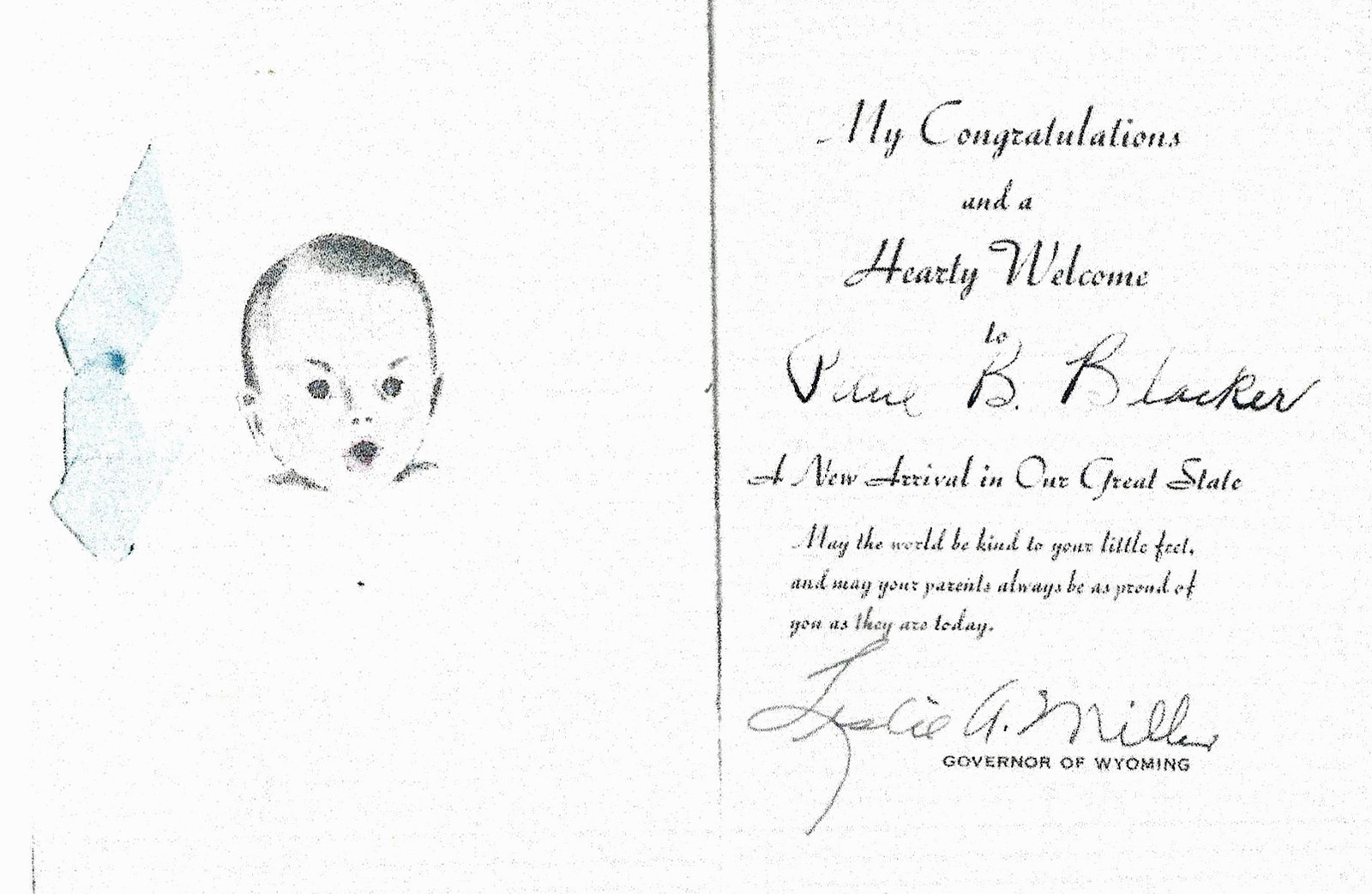 This is a copy of the welcome card that I received from Governor Miller in late 1937.
This is a copy of the welcome card that I received from Governor Miller in late 1937.
My actual birth certificate did not show up until 1993.
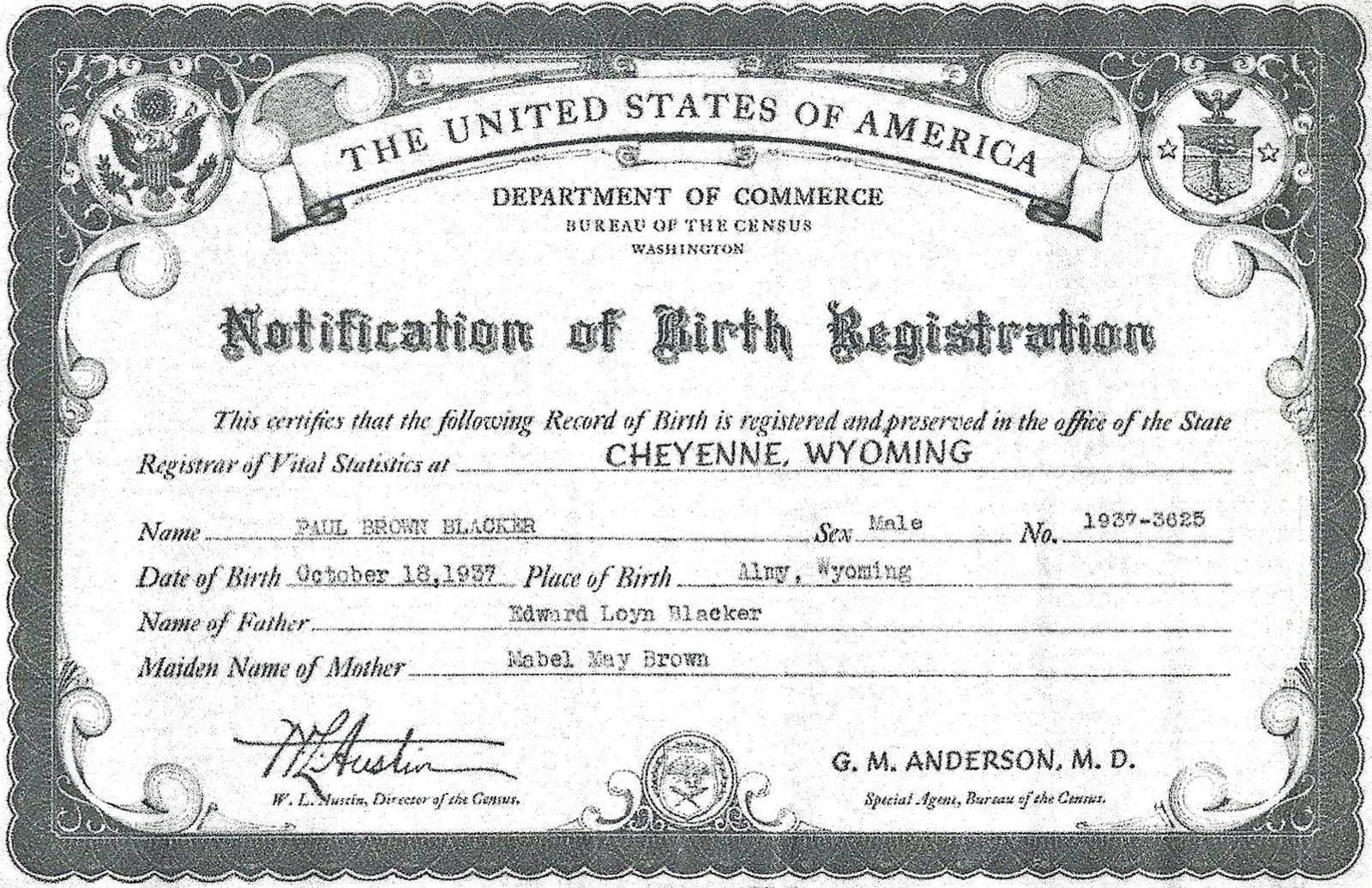
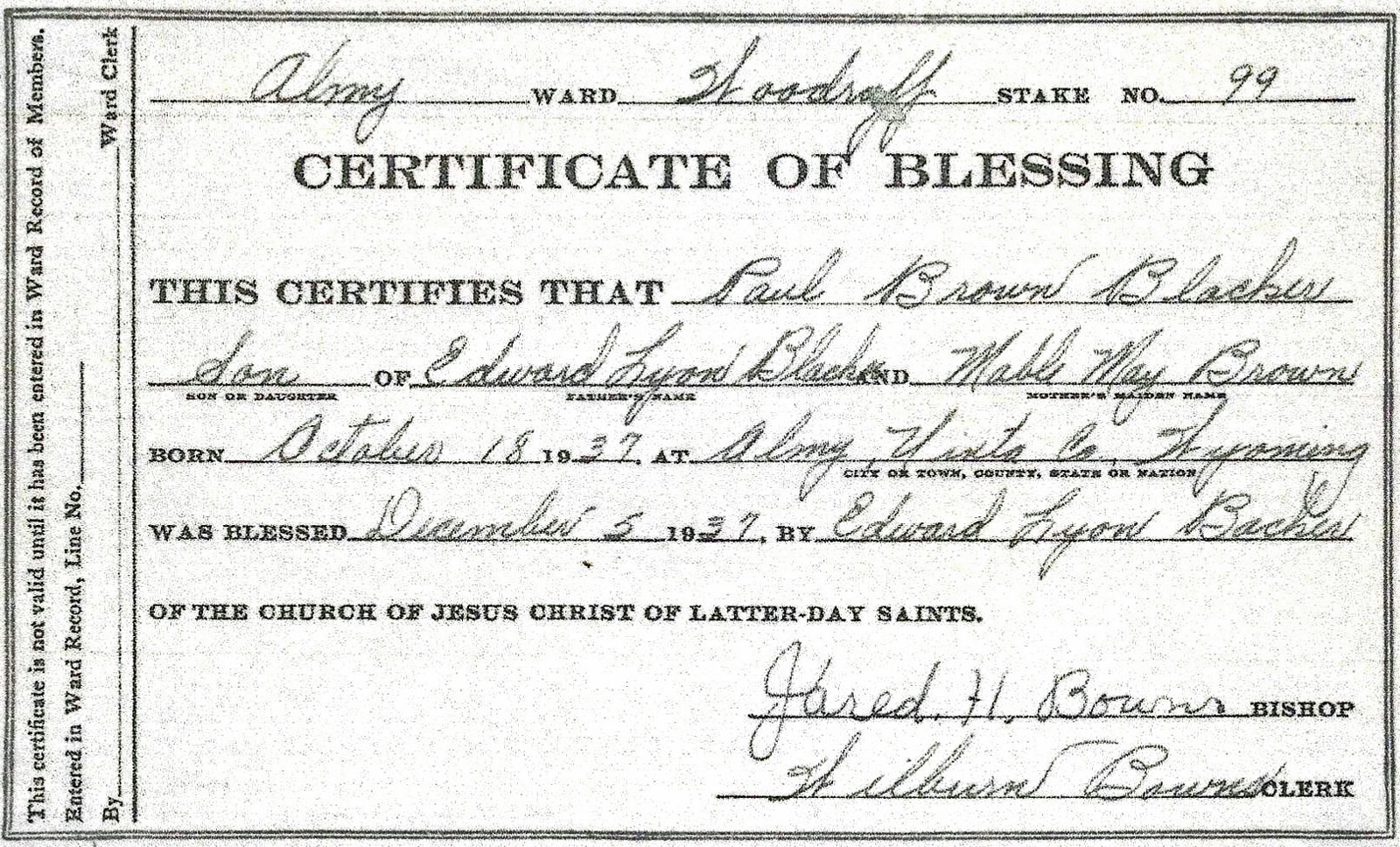

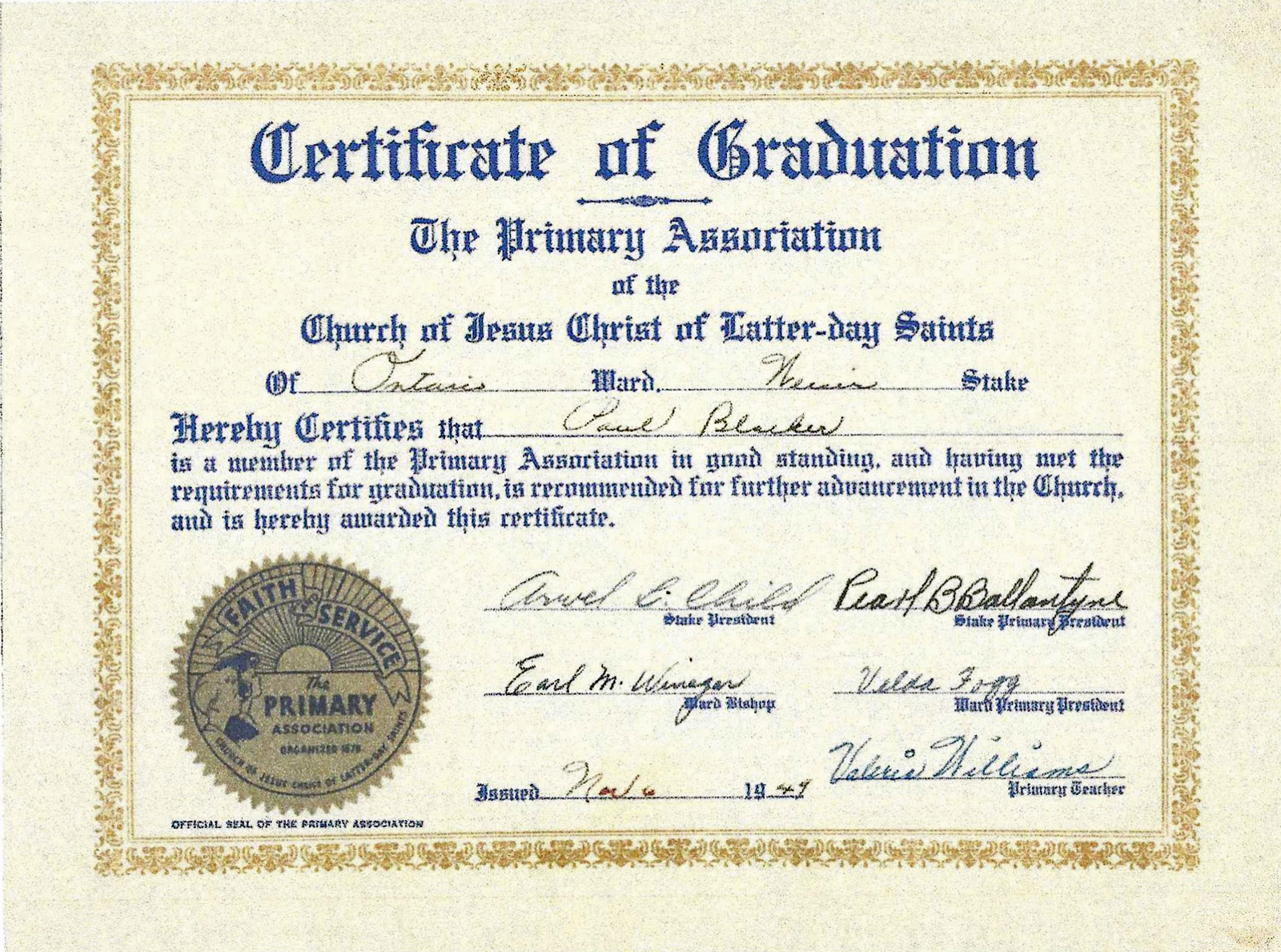
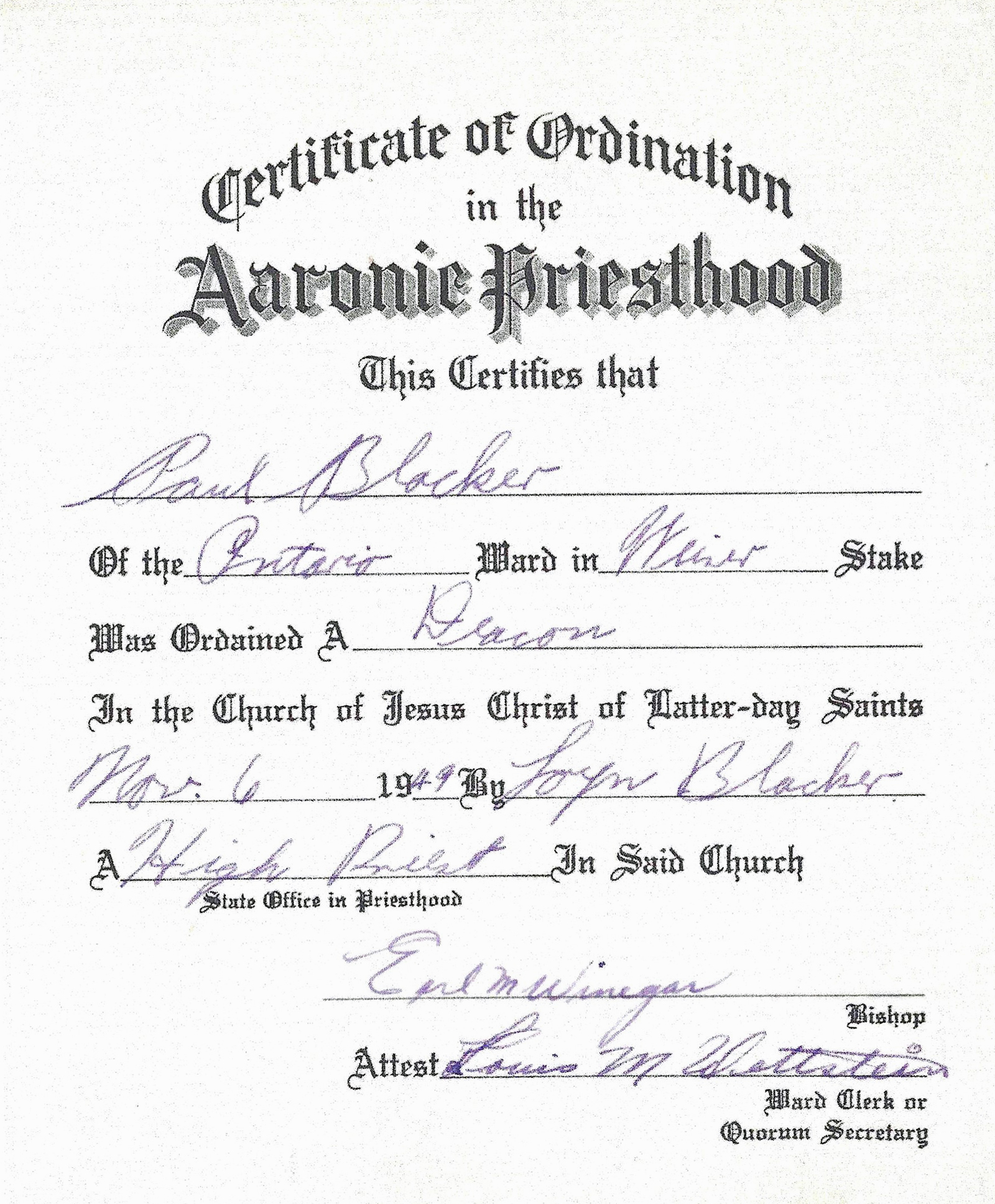
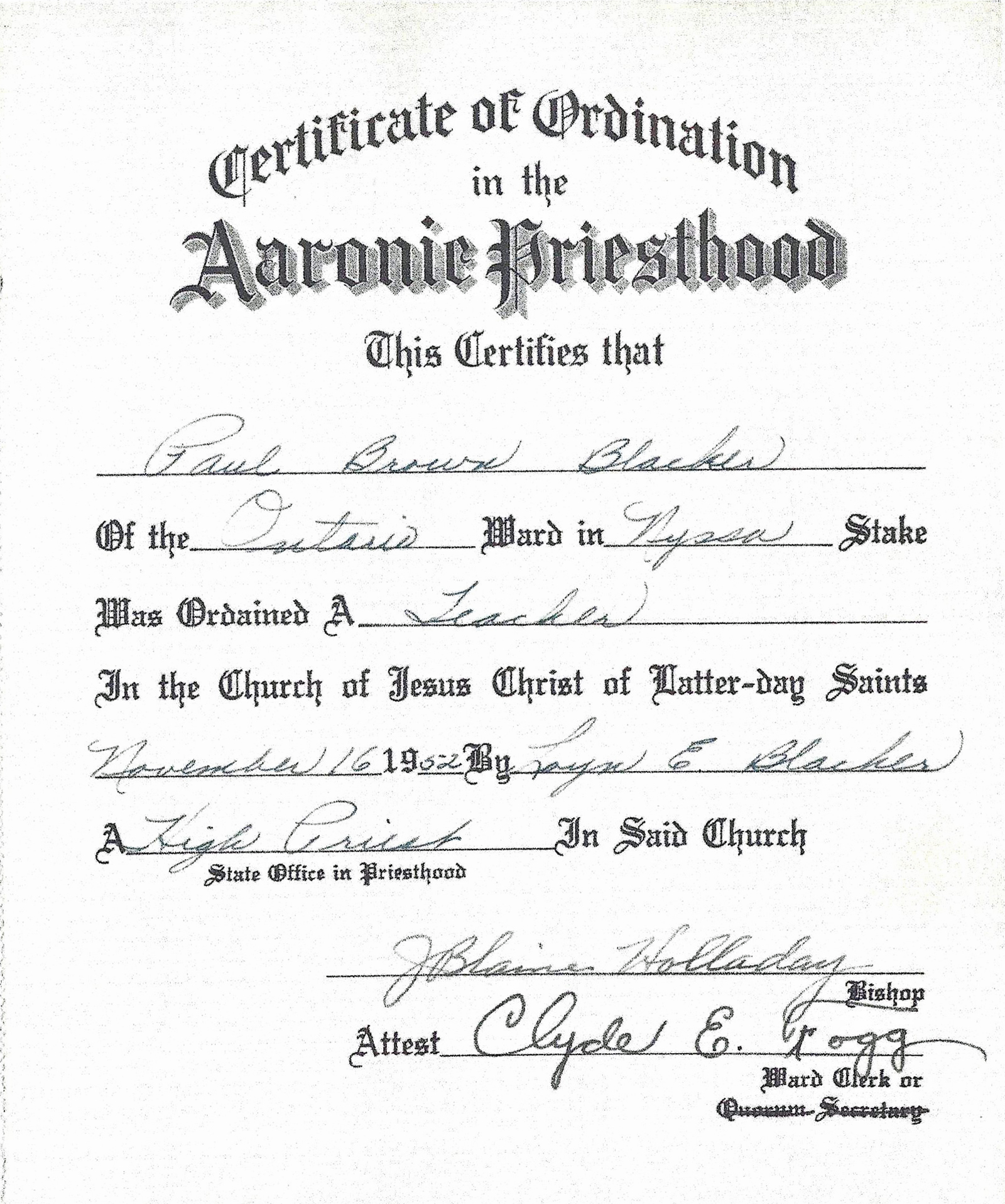 Ordination As A Teacher
Ordination As A Teacher
